Hong Kong is home to a variety of unique and fascinating bird species, including both migratory and resident birds.
The region’s location along the East Asian-Australasian Flyway makes it an important stopover for migratory birds on their journey between breeding and wintering areas.
Hong Kong’s subtropical climate, diverse habitats, and protected areas provide rich breeding, feeding, and roosting grounds for a wide range of bird species.
From the majestic Black Kite soaring high in the sky to the tiny Olive-backed Sunbird flitting among flowers, there is something to awe and marvel at for every bird enthusiast in Hong Kong.
In this article, we will explore some of the remarkable bird species found in Hong Kong and the importance of conserving their habitats.
1. Light-Vented Bulbul
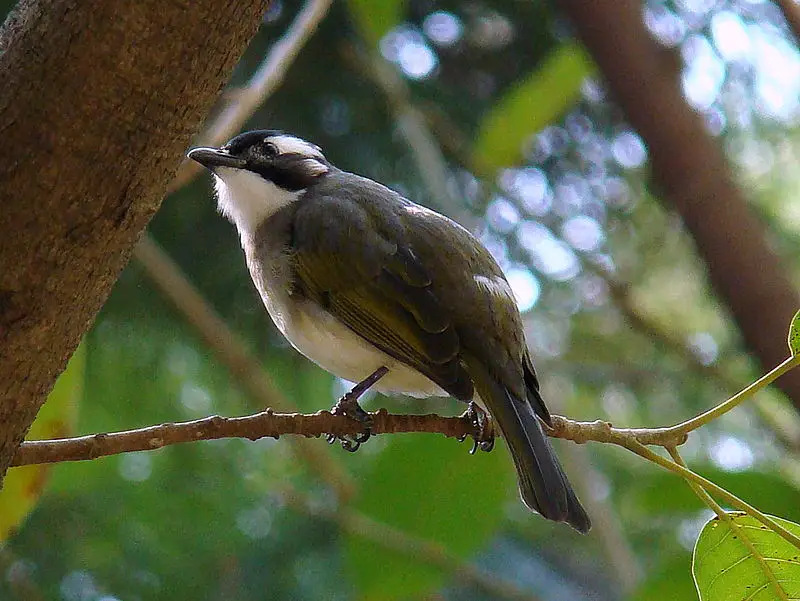
The light-vented bulbul is a species of songbird found in central and southern China, Hong Kong, Macao, northern Vietnam, Japan and Taiwan.
It typically inhabits lightly wooded habitats but can also be seen frequenting towns, suburbs and urban parks.
This bird has olive green upperparts with yellowish underparts; its wings are black tipped with white patches whilst the tail is entirely dark brown.
Its call consists of low whistles that vary from sharp to soft as well as raspy chatters which it uses for communication purposes between members of its flock.
Furthermore this small sized bird feeds on insects such as flies or beetles along with other invertebrates like worms or snails among others making it an important part of many ecosystems across Asia.Scientific classification:
| Kingdom | Animalia |
| Phylum | Chordata |
| Class | Aves |
| Order | Passeriformes |
| Family | Pycnonotidae |
| Genus | Pycnonotus |
| Species | P. sinensis |
Also Featured In: Most Common Birds in China, Most Common Taiwan Birds
2. Collared Crow
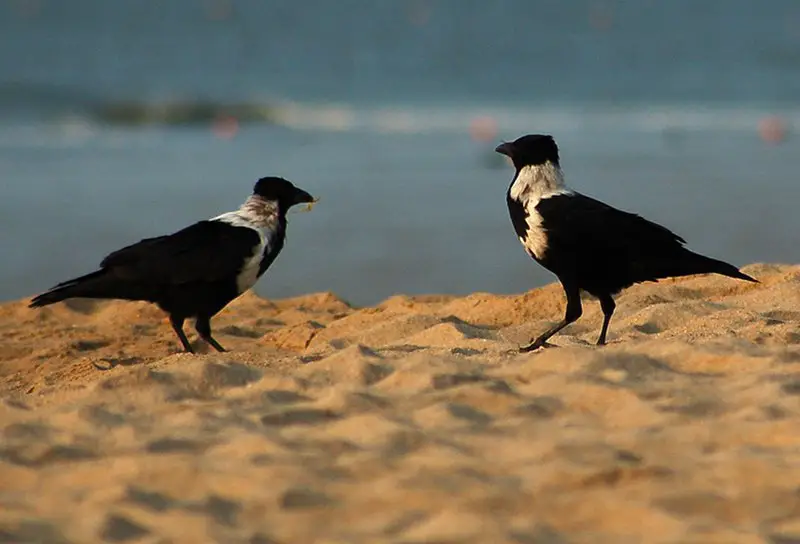
The collared crow is an impressive bird native to China and north of Vietnam. With glossy black plumage, the only exception being its white collar around its neck that gives it a distinguished look.
It stands about 52-55 cm in length with proportionately longer wings, tail, and bill than other species like carrion crows or ravens.
They are usually seen perching on trees or ground scavenging for food but they also make nests high off the ground which can reach up to 10 meters tall.
These birds are omnivorous so they eat a wide variety of foods including fruits, seeds insects and small animals such as frogs.
Collared Crows have been observed using tools such as sticks to get their food from hard places making them one of the most intelligent members amongst Corvidae family.Scientific classification:
| Kingdom | Animalia |
| Phylum | Chordata |
| Class | Aves |
| Order | Passeriformes |
| Family | Corvidae |
| Genus | Corvus |
| Species | C. torquatus |
3. Greater Coucal
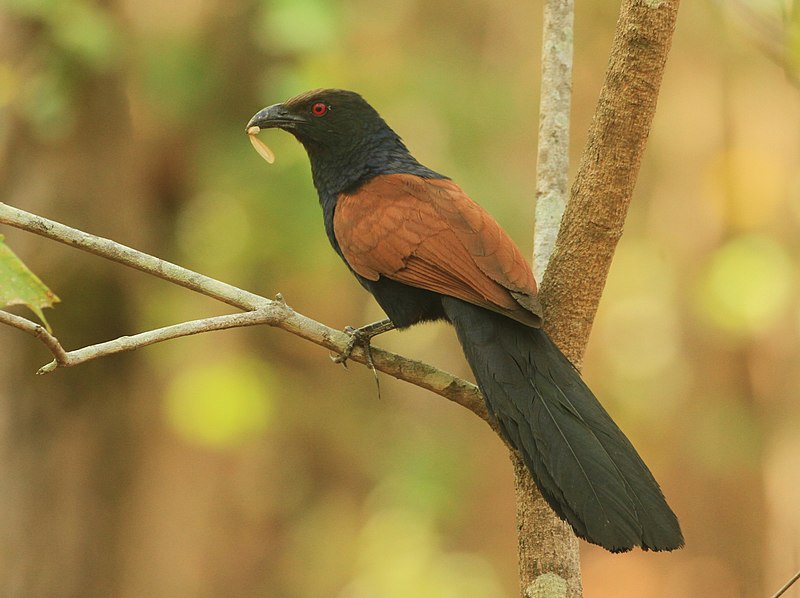
The Greater Coucal is a large, crow-like bird that belongs to the Cuculiformes order. It has a long tail and coppery brown wings.
These birds are found in many habitats across India and Southeast Asia, ranging from jungles to suburban gardens.
They feed on insects as well as small vertebrates such as frogs, lizards or snakes which they capture with their strong beak.
The males have glossy black plumage while females are dark brown above with buff underparts.
During breeding season these birds make loud croaking calls and can often be heard at night when they become active after sundown looking for food sources like termites or grasshoppers between bushes or low branches of trees close by water bodies like rivers, lakes etc.
This species plays an important role in maintaining ecological balance in its habitat by controlling pest populations through predation so it is essential that we protect them from hunting and other threats for future generations to enjoy.Scientific classification:
| Kingdom | Animalia |
| Phylum | Chordata |
| Class | Aves |
| Order | Cuculiformes |
| Family | Cuculidae |
| Genus | Centropus |
| Species | C. sinensis |
Also Featured In: Common Birds in India, Birds of Goa
4. Asian Koel
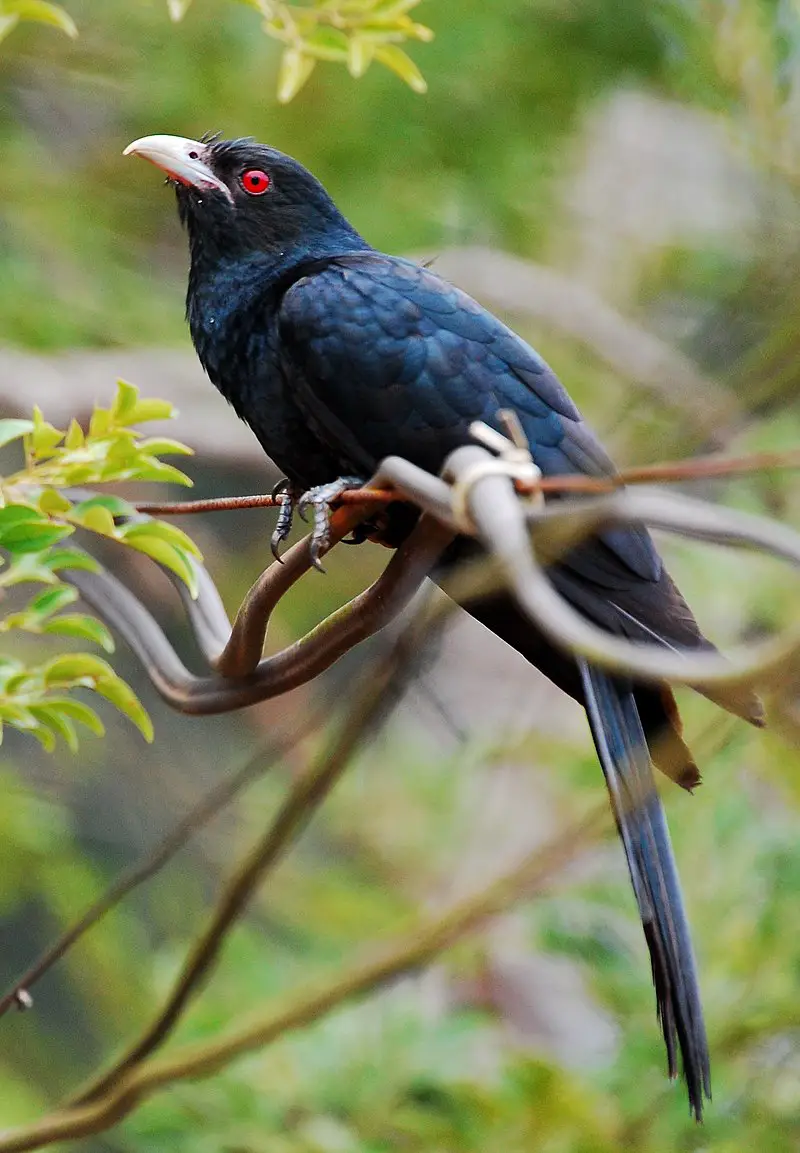
The Asian koel is a member of the Cuculiformes family, found in India, China and Southeast Asia. It shares its range with two closely related species – black-billed koels and Pacific koels.
This bird exhibits brood parasitism; it lays its eggs in nests of other birds, who then unknowingly become foster parents to their young.
Characterised by long tails and glossy feathers that vary from deep blue to greenish-black depending on region, these birds are known for their loud call which can be heard during both day or night time.
They feed mainly on fruits but also take insects when available.
All in all, the Asian Koel is an interesting species that has adapted itself well over many centuries within different ecosystems across Asia.Scientific classification:
| Kingdom | Animalia |
| Phylum | Chordata |
| Class | Aves |
| Order | Cuculiformes |
| Family | Cuculidae |
| Genus | Eudynamys |
| Species | E. scolopaceus |
Also Featured In: Birds that Live in Tamil Nadu, Common Birds of Mumbai
5. Black Kite
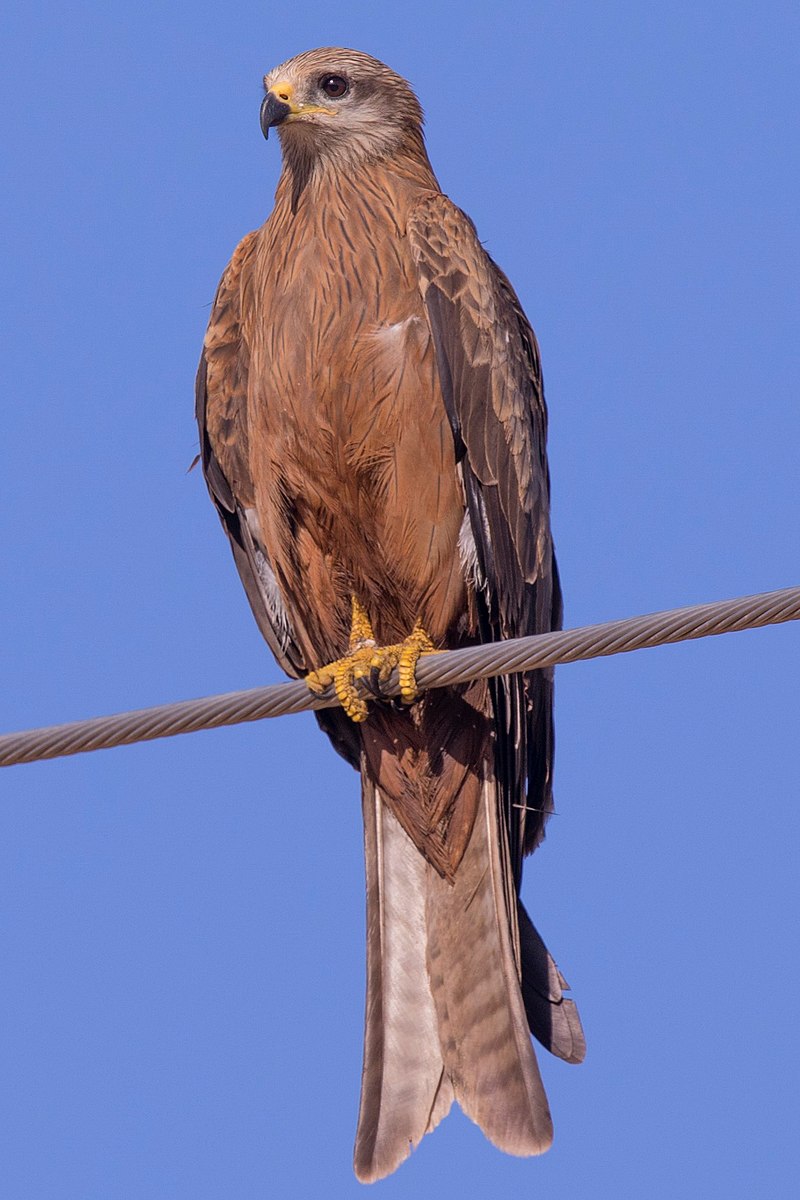
The black kite is one of the most abundant species of diurnal birds of prey in the world, with a global population estimated to be up to 6 million individuals.
It belongs to the family Accipitridae and has medium-sized body size. The wingspan can range from 150 cm – 180cm wide.
They have dark brown feathers on their back and light brown or grey underparts and long forked tails that help it maneuver through.
Its environment while hunting for food like insects, small mammals, reptiles etc., along with scavenging opportunities when available.
Black Kites are found across several continents including Europe, Africa, Asia Minor & Australia where they breed during spring in nests made among trees near wetlands or riversides;
migratory populations move southward away from winter cold temperatures as far east as India & Japan before returning home again next season.Scientific classification:
| Kingdom | Animalia |
| Phylum | Chordata |
| Class | Aves |
| Order | Accipitriformes |
| Family | Accipitridae |
| Genus | Milvus |
| Species | M. migrans |
Also Featured In: Common Birds in the Cities, Summer Birds that Live around Us
6. Spotted Dove
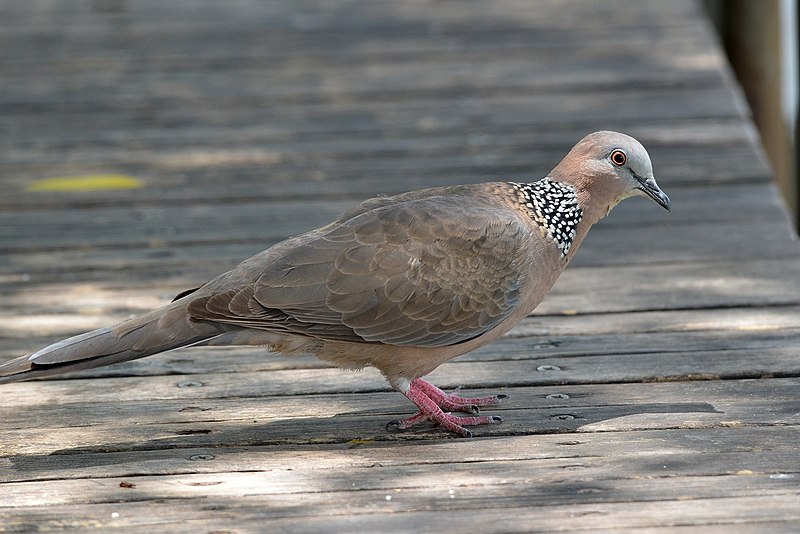
The Spotted Dove is a common species of pigeon found in the Indian subcontinent and Southeast Asia. It has an elegant, slender body with small head, long tail feathers and spotted wings.
Its coloring ranges from grey to brownish-grey on its upperparts with white underparts that are speckled black or dark grey. The male generally has more prominent spots than the female.
They feed mainly on seeds but will also consume insects when available during breeding season as well as berries, grains and fruits throughout their range.
These birds typically live in pairs or small groups near water sources such as ponds, rivers or streams where they can find food easily while staying safe from predators like cats and hawks.Scientific classification:
| Kingdom | Animalia |
| Phylum | Chordata |
| Class | Aves |
| Order | Columbiformes |
| Family | Columbidae |
| Genus | Spilopelia |
| Species | S. chinensis |
Also Featured In: Hawaii Big Island Birds You Should Know, Birds that Commonly Found in Bali
7. Siberian Crane
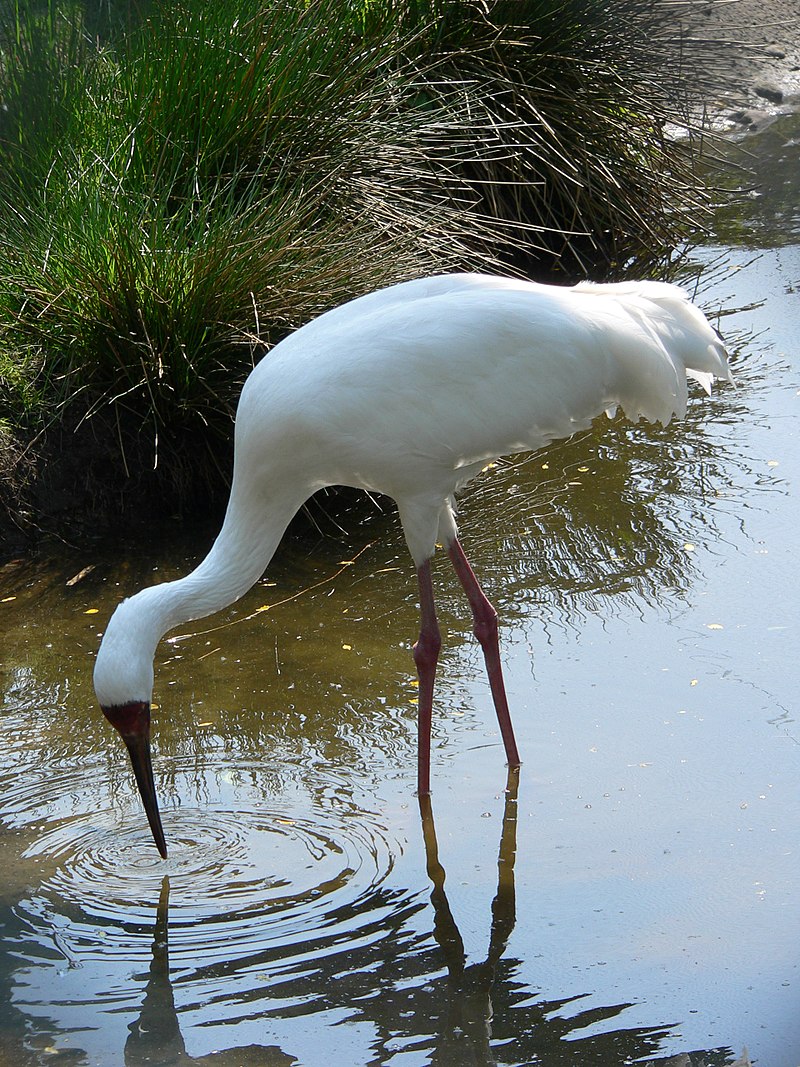
The Siberian crane is a majestic white bird of the family Gruidae. It has two distinct breeding populations in Russia, one in eastern and other in western Arctic tundra region.
In flight it can be identified by its black primary feathers which stand out against its otherwise snowy white body.
These graceful birds have an average wingspan of 2 metres and are known to migrate from their wintering grounds at India’s Keoladeo National Park to Siberia during summer months for breeding purposes.
They feed mainly on plants, grains, mollusks as well as small amphibians or fish when available near wetlands.
Due to loss of habitat and hunting these elegant cranes are listed as critically endangered species with less than 3200 individuals remaining worldwide today making them highly vulnerable to extinction if necessary conservation measures aren’t taken soon enough.Scientific classification:
| Kingdom | Animalia |
| Phylum | Chordata |
| Class | Aves |
| Order | Gruiformes |
| Family | Gruidae |
| Genus | Leucogeranus Bonaparte, 1855 |
| Species | L. leucogeranus |
Also Featured In: Native Pakistani Birds, Birds of Taiga
8. Yellow-Bellied Prinia
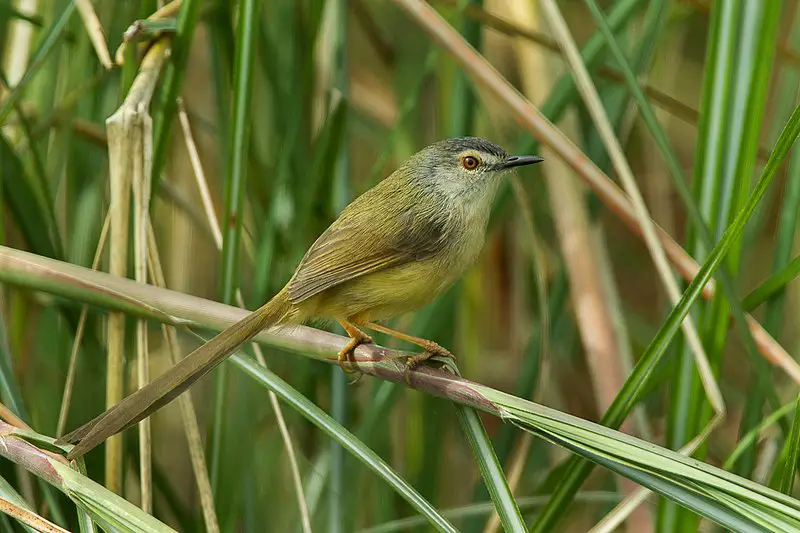
The Yellow-bellied Prinia (Prinia flaviventris) is a species of bird in the family Cisticolidae. It lives mainly in Pakistan, but can also be found along the southern Himalayan foothills and northeastern Indian subcontinent to Southeast Asia.
This small brownish grey bird has a yellow belly with white barring on its wings and tail feathers. Its call is described as being a series of loud chirps or trilling notes which it repeats rapidly for several seconds at a time.
The diet includes flying insects such as moths, beetles, grasshoppers and ants that they catch while hovering over vegetation close to the ground during their search for food.
They are usually seen singly or in pairs near hedges or scrubby areas where there is plenty of cover from predators like snakes and cats.Scientific classification:
| Kingdom | Animalia |
| Phylum | Chordata |
| Class | Aves |
| Order | Passeriformes |
| Family | Cisticolidae |
| Genus | Prinia |
| Species | P. flaviventris |
9. Shorebirds
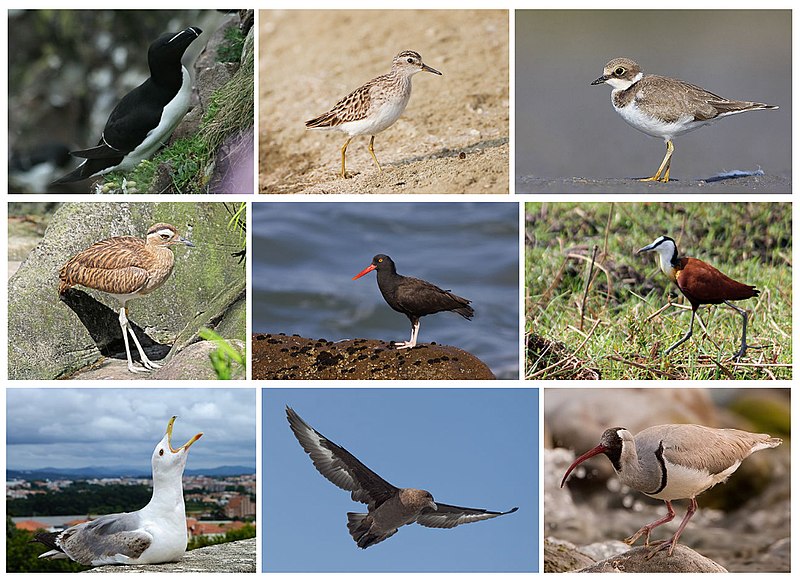
Shorebirds, a diverse group of birds in the Charadriiformes order, are found near water on every continent except Antarctica.
These small to medium-sized birds feed mainly on invertebrates and other small animals but can also be pelagic seabirds or inhabit deserts.
Shorebirds use their long bills to probe mudflats for food like worms and mollusks while some species plunge into the ocean’s depths in search of crustaceans such as crabs and shrimp.
They have strong legs equipped with webbed feet which allow them to move quickly when searching for prey across wetlands, sandbars, beaches and swamps.
Their feathers make them well adapted to life by land or sea due to its hydrophobic nature which helps reduce drag during swimming or flying through windy conditions making it easier for shorebirds survive tough environments around the world.Scientific classification:
| Kingdom | Animalia |
| Phylum | Chordata |
| Class | Aves |
| Infraclass | Neognathae |
| Clade | Neoaves |
| Clade | Gruimorphae |
| Order | Charadriiformes Huxley, 1867 |
Also Featured In: Beautiful Brazilian Birds, Water Birds Live around Us
10. Oriental Magpie-Robin
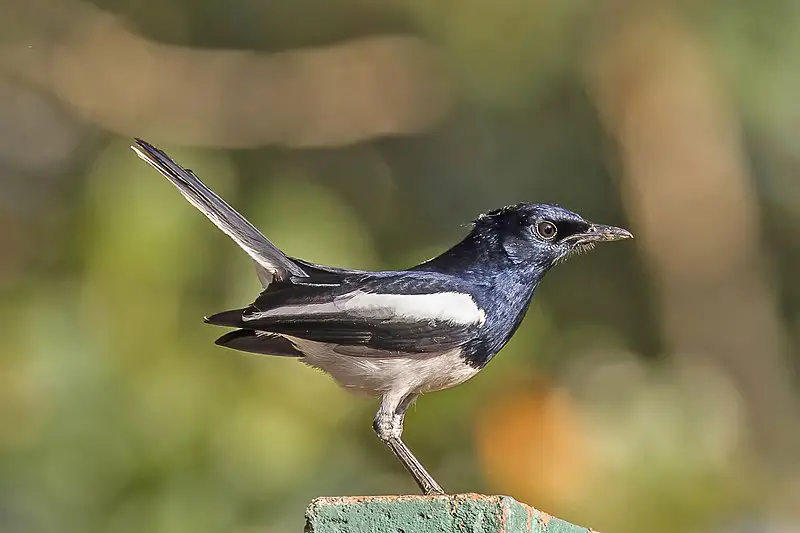
The Oriental magpie-robin is a beautiful passerine bird found across the Indian subcontinent and parts of Southeast Asia.
It can be easily identified by its black and white plumage, long tail that it holds upright while perched or foraging on the ground.
They are known to sing melodiously which makes them popular as cage birds in many countries.
These birds feed mainly on insects but also consume fruits, berries and nectar from flowers during certain times of the year.
Their population numbers have been declining due to destruction of their natural habitats like deforestation.
However, conservation efforts have seen some success in recent years with more areas being set aside for protection and preservation.Scientific classification:
| Kingdom | Animalia |
| Phylum | Chordata |
| Class | Aves |
| Order | Passeriformes |
| Family | Muscicapidae |
| Genus | Copsychus |
| Species | C. saularis |
Also Featured In: Most Common Types of Bangladeshi Birds, Birds that You’ll Find in Kolkata
11. Black-Capped Kingfisher
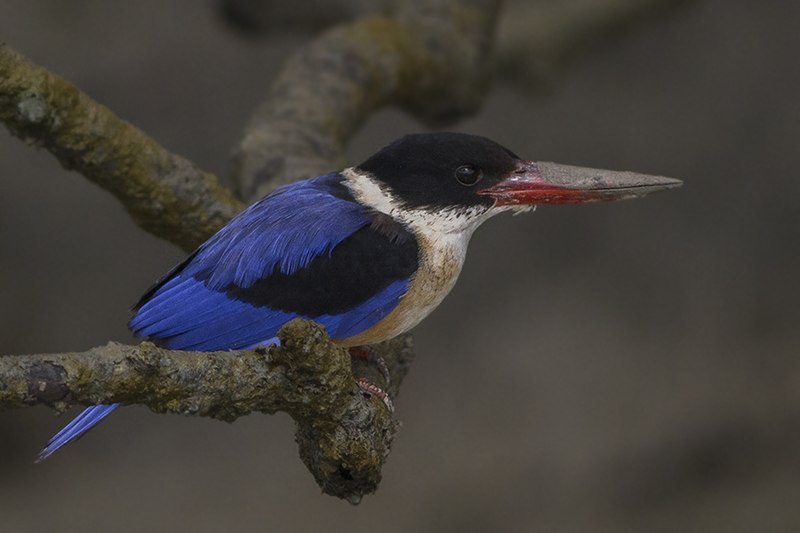
The Black-capped Kingfisher is a beautiful species of tree kingfishers found in tropical Asia from India east to China, Korea and Southeast Asia.
Its striking features include its black cap that contrasts with its bright blue back, wings and tail.
It has white underparts which makes it easily identifiable when perched atop trees or flying above the ground searching for food.
During winter months some northern populations migrate south seeking warmer climates such as Sri Lanka, Thailand, Borneo and Java.
The diet of this bird consists mainly of insects but may also feed on small reptiles like lizards or snakes if available.
They can be seen generally near water bodies where they hunt their prey by diving into the waters from a high perch.Scientific classification:
| Kingdom | Animalia |
| Phylum | Chordata |
| Class | Aves |
| Order | Coraciiformes |
| Family | Alcedinidae |
| Subfamily | Halcyoninae |
| Genus | Halcyon |
| Species | H. pileata |
Also Featured In: Most Common Birds of Ko Samui, Native Birds Of Ko Chang District
12. White-Breasted Waterhen
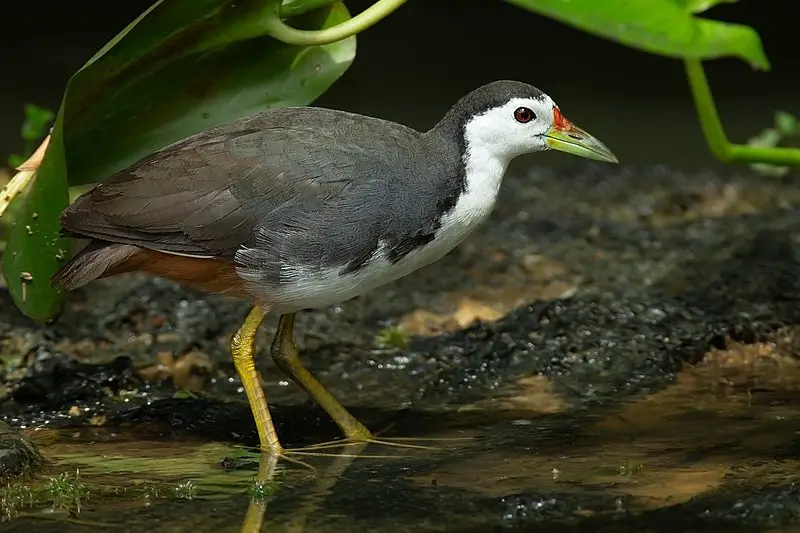
The White-breasted Waterhen is a stunning species of bird from South and Southeast Asia. It has a striking appearance, with its dark slaty plumage contrasted by the clean white of its face, breast and belly.
This bold waterbird can often be seen slowly walking around marshes or even drains near busy roads with its tail held upright in an unmistakable pose.
They are omnivores which feed on both plants and small animals such as insects and invertebrates.
The White-breasted Waterhen plays an important role in their ecosystems as they help to keep it balanced by consuming pests that could potentially cause damage to crops or other plant life if left unchecked.Scientific classification:
| Kingdom | Animalia |
| Phylum | Chordata |
| Class | Aves |
| Order | Gruiformes |
| Family | Rallidae |
| Genus | Amaurornis |
| Species | A. phoenicurus |
Also Featured In: Common Birds in Kerala, Common Birds in Bangalore
13. Common Tailorbird
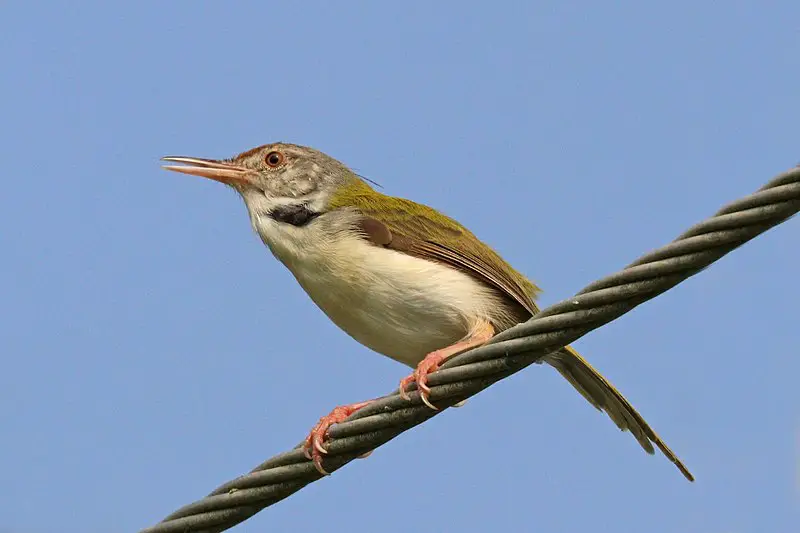
The Common Tailorbird is a songbird found across tropical Asia, popular for its unique nests made of leaves “sewn” together.
It was immortalized by Rudyard Kipling in his Jungle Book as Darzee and can often be seen in urban gardens.
Though shy birds that are usually hidden within vegetation, their loud calls give away their presence.
They are distinctive with a brownish plumage on the upperparts and paler gray underparts; white throats speckled black mark them out from other similar species.
They feed mainly on insects such as spiders, caterpillars and grasshoppers but will also eat fruit when available.
Breeding season begins around March or April with males singing to claim territories before beginning to weave intricate leafy structures for nesting sites – an amazing feat.
All in all these delightful little birds make wonderful additions to any garden setting – just remember not to get too close.Scientific classification:
| Kingdom | Animalia |
| Phylum | Chordata |
| Class | Aves |
| Order | Passeriformes |
| Family | Cisticolidae |
| Genus | Orthotomus |
| Species | O. sutorius |
Also Featured In: Birds That Live In Phuket Island,
14. Black-Faced Spoonbill
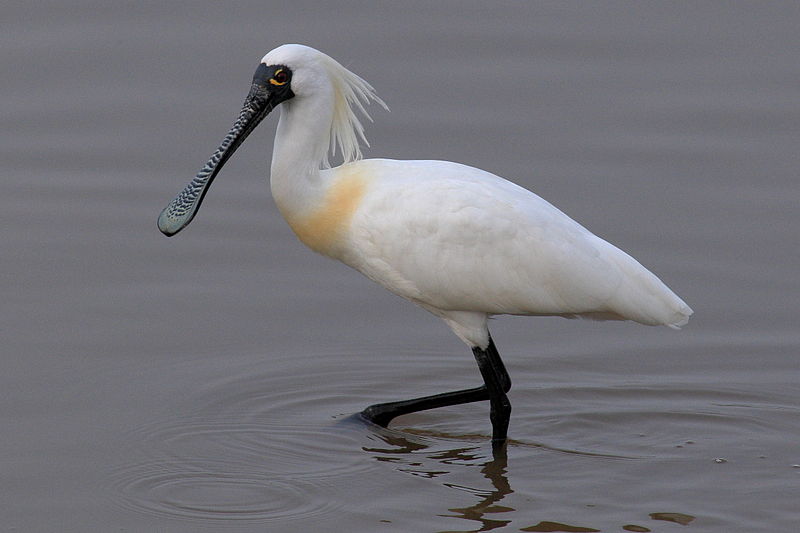
The Black-faced Spoonbill is a rare and endangered species of wading bird, found in eastern Asia.
It has unique physical characteristics like its dorso-ventrally flattened bill which it uses to feed by touch.
They are large birds with white feathers, black face, neck and wings and yellow crowns on their heads.
These solitary birds spend most of the year near coastal wetlands or along tidal mudflats where they search for food such as fish, crustaceans and molluscs using their long beaks to dig into the sand or water vegetation.
Conservation efforts such as creating safe habitats have helped this species survive despite its rarity but more needs to be done if we hope to save them from extinction.Scientific classification:
| Kingdom | Animalia |
| Phylum | Chordata |
| Class | Aves |
| Order | Pelecaniformes |
| Family | Threskiornithidae |
| Genus | Platalea |
| Species | P. minor |
Also Featured In: Common Birds in Japan, Tokyo Birds You Need to Know
15. Old World Flycatchers
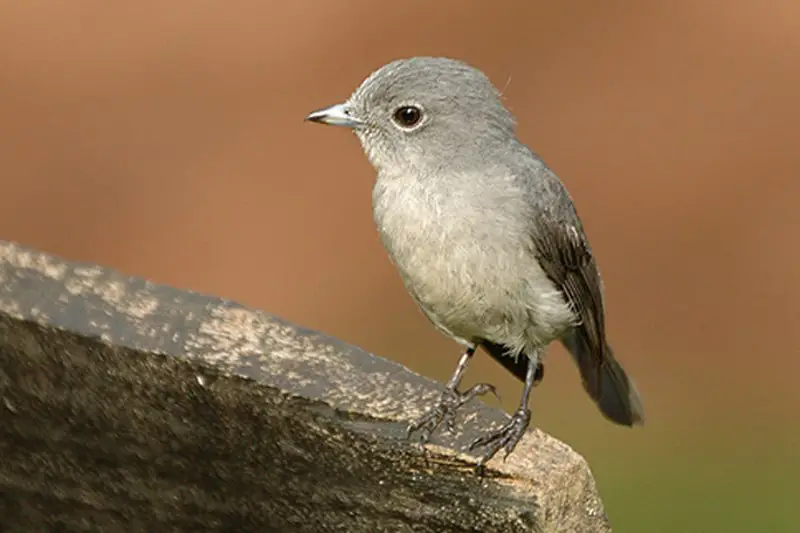
The Old World Flycatcher is a family of small passerine birds, native to Europe, Africa and Asia. They are mainly insectivorous arboreal birds that feed on insects they catch in the air or trees.
Their wingspan ranges from 5-11 inches long with males usually being slightly larger than females.
The coloration of these birds can range greatly depending on species but typically have dull greyish brown upperparts and pale undersides which help them blend into their environment for hunting purposes.
Bluethroat (Luscinia svecica) and Northern Wheatear (Oenanthe oenanthe) are two exceptions as they can be found in North America too.
These charming little creatures make fun additions to birdwatching lists all over the world because of their vibrant colors and interesting behaviors.Scientific classification:
| Kingdom | Animalia |
| Phylum | Chordata |
| Class | Aves |
| Order | Passeriformes |
| Superfamily | Muscicapoidea |
| Family | Muscicapidae Fleming J., 1822 |
Also Featured In: Common Uzbekistan Birds, Native Birds of Kazakhstan
16. Black-Naped Oriole
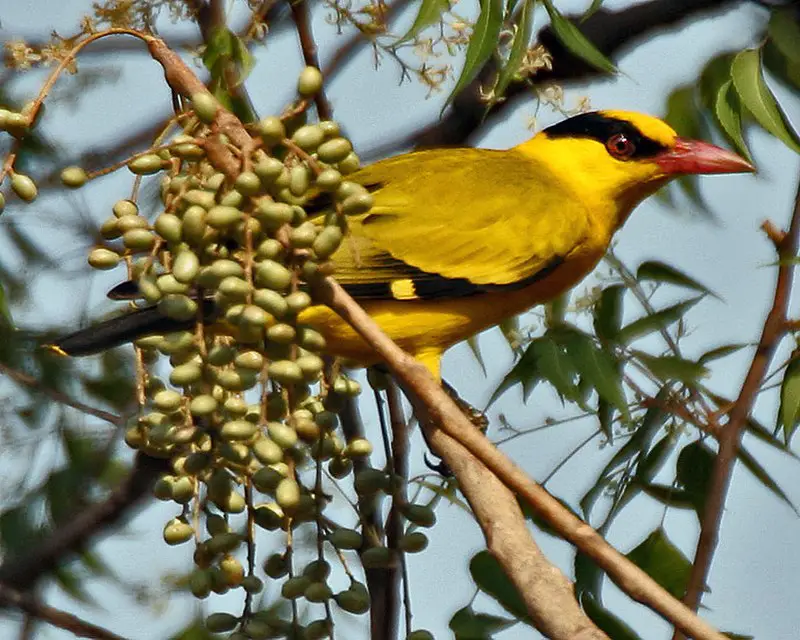
The Black-naped Oriole is a stunning bird native to Asia. It has bright yellow feathers with black markings on its head, wings and tail. Its beak and legs are also black in colour.
These birds can grow up to 25 cm long and they have very distinctive eye stripes – the eye stripe of this species is broader than that of the Indian Golden Oriole.
They mostly inhabit forests as well as open areas such as grasslands, orchards and gardens where there are plenty of trees for them to feed on insects or fruits like figs, dates and berries.
The Black-naped Orioles live in small flocks during their nonbreeding season but become solitary when breeding begins which usually occurs between March and May each year depending upon location.Scientific classification:
| Kingdom | Animalia |
| Phylum | Chordata |
| Class | Aves |
| Order | Passeriformes |
| Family | Oriolidae |
| Genus | Oriolus |
| Species | O. chinensis |
Also Featured In: Birds of the Philippines, Common Philippines Birds
17. Little Egret
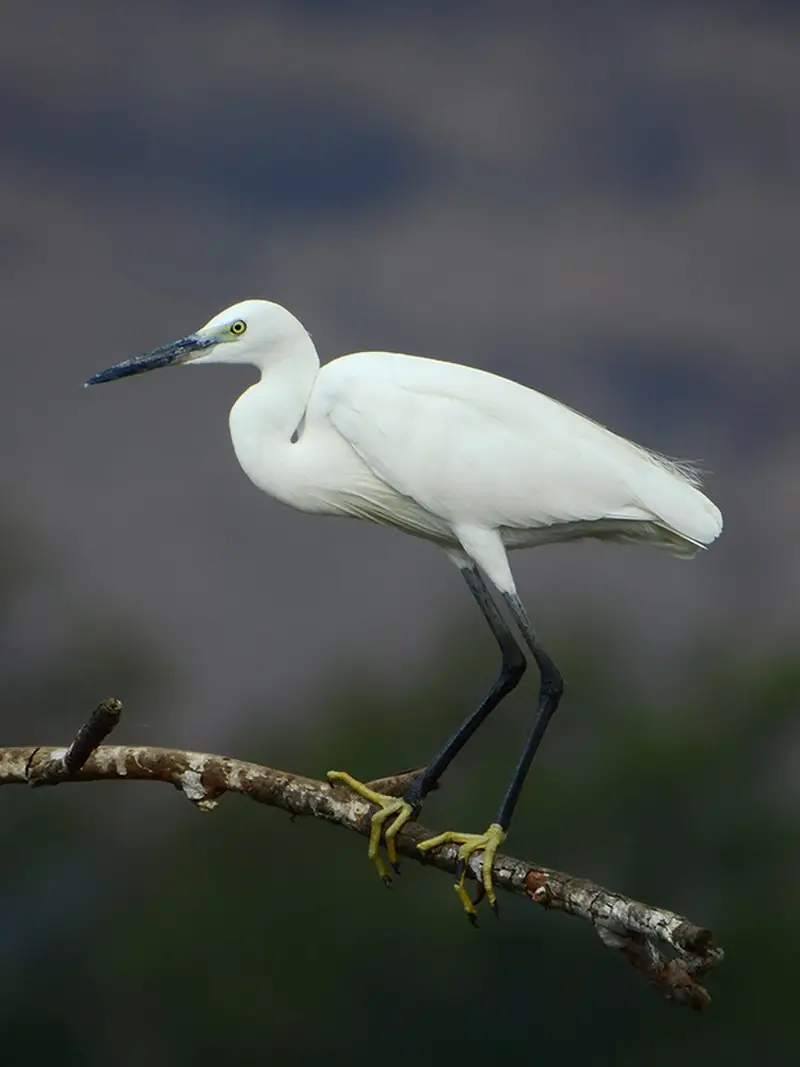
The Little Egret is a small white heron with sleek black beak, long black legs and in some cases yellow feet.
It can be found near aquatic areas where it feeds on molluscs, amphibians and insects while also occasionally feeding of land creatures such as lizards or rodents.
Breeding seasonally they make platform nests of sticks being built either by themselves or in colonies alongside other water birds.
They are widely distributed across the world from Europe to Africa, Asia to Australia making them an easily recognisable bird species often seen at waterside locations searching for their next meal.Scientific classification:
| Kingdom | Animalia |
| Phylum | Chordata |
| Class | Aves |
| Order | Pelecaniformes |
| Family | Ardeidae |
| Genus | Egretta |
| Species | E. garzetta |
Also Featured In: Egyptian Birds, Swamps Birds You Should Know
18. Eurasian Wryneck
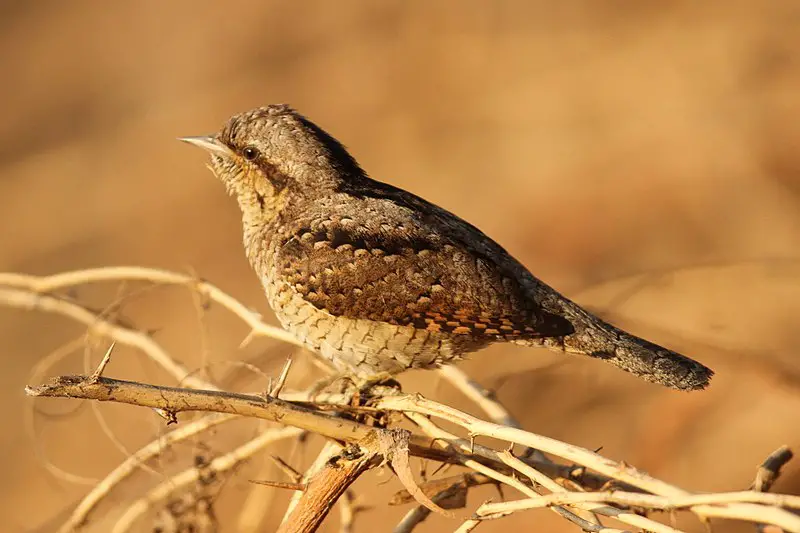
The Eurasian Wryneck is a species of woodpecker found in temperate regions of Europe and Asia. They breed during the summer months, but migrate south to tropical Africa or southern Asia for winter.
These birds are quite adaptable when it comes to their habitat, as they can be seen in open countryside, woodland, orchards and gardens alike.
To identify them you should look out for their distinctive brownish-grey feathers with black bars on the wings and tail; males also have red markings around their neck too.
Their diet consists mainly of insects which they find by probing into loose bark on trees or digging through soil with its sharp bill.
All in all an amazing bird that deserves more attention.Scientific classification:
| Kingdom | Animalia |
| Phylum | Chordata |
| Class | Aves |
| Order | Piciformes |
| Family | Picidae |
| Genus | Jynx |
| Species | J. torquilla |
Also Featured In: Native Birds Of Germany, Ukrainian Birds You Should Know
19. Starling
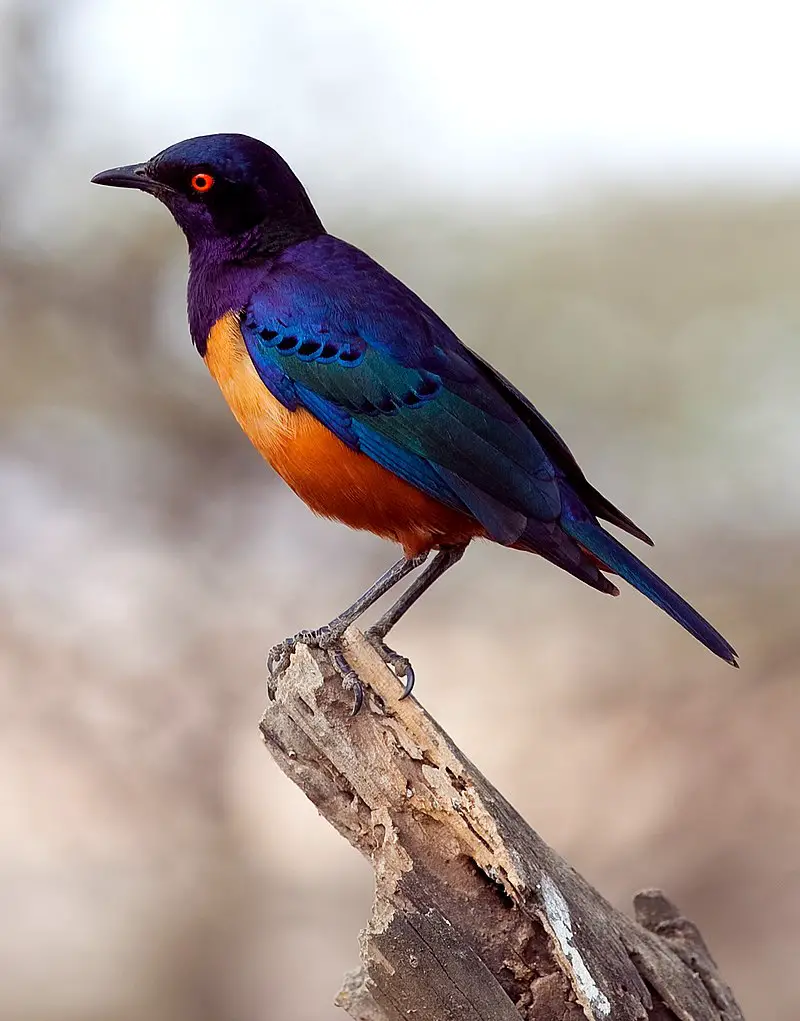
Starlings are small to medium-sized birds belonging to the Sturnidae family. They have a unique iridescent plumage, making them popularly known as glossy starlings in Africa and mynas in Asia.
Starlings inhabit Europe, Asia and Africa; some species even migrate between continents for food or better climates.
These birds form large flocks of up to thousands at a time during their migration periods, creating spectacular visual displays while they soar through the sky.
Besides being beautiful creatures, starlings can also imitate sounds such as human speech – an impressive feat that has been documented by many ornithologists over the years.Scientific classification:
| Kingdom | Animalia |
| Phylum | Chordata |
| Class | Aves |
| Order | Passeriformes |
| Suborder | Passeri |
| Family | Sturnidae Rafinesque, 1815 |
Also Featured In: Birds of United Kingdom, Most Common Winter Birds
20. Spoonbills
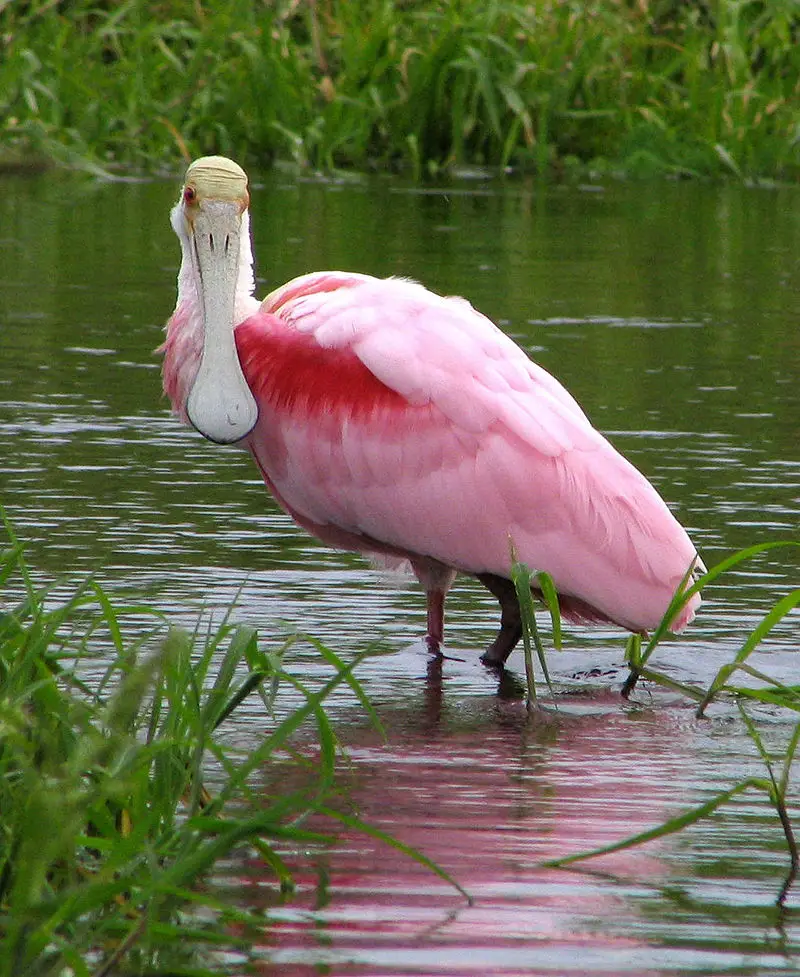
Spoonbills are large wading birds belonging to the genus Platalea. Characterized by their long legs and distinctive spoon-shaped beaks, these birds can be found all over the world except Antarctica.
The name of this genus derives from Ancient Greek meaning “broad”, referring to their bill’s shape.
There are six species of Spoonbill recognized – though they usually form a single group, sometimes it is divided into three genera.
These graceful creatures feed mainly on small aquatic organisms such as insects and fish which they catch with an open-mouth technique while sweeping through shallow waters in search for food.
They typically breed near water bodies during springtime when there’s plenty of food available around them.Scientific classification:
| Kingdom | Animalia |
| Phylum | Chordata |
| Class | Aves |
| Order | Pelecaniformes |
| Family | Threskiornithidae |
| Subfamily | Plataleinae |
| Genus | Platalea Linnaeus, 1758 |
Also Featured In: Birds of South African, Birds Found in Hungary
21. Red-Whiskered Bulbul
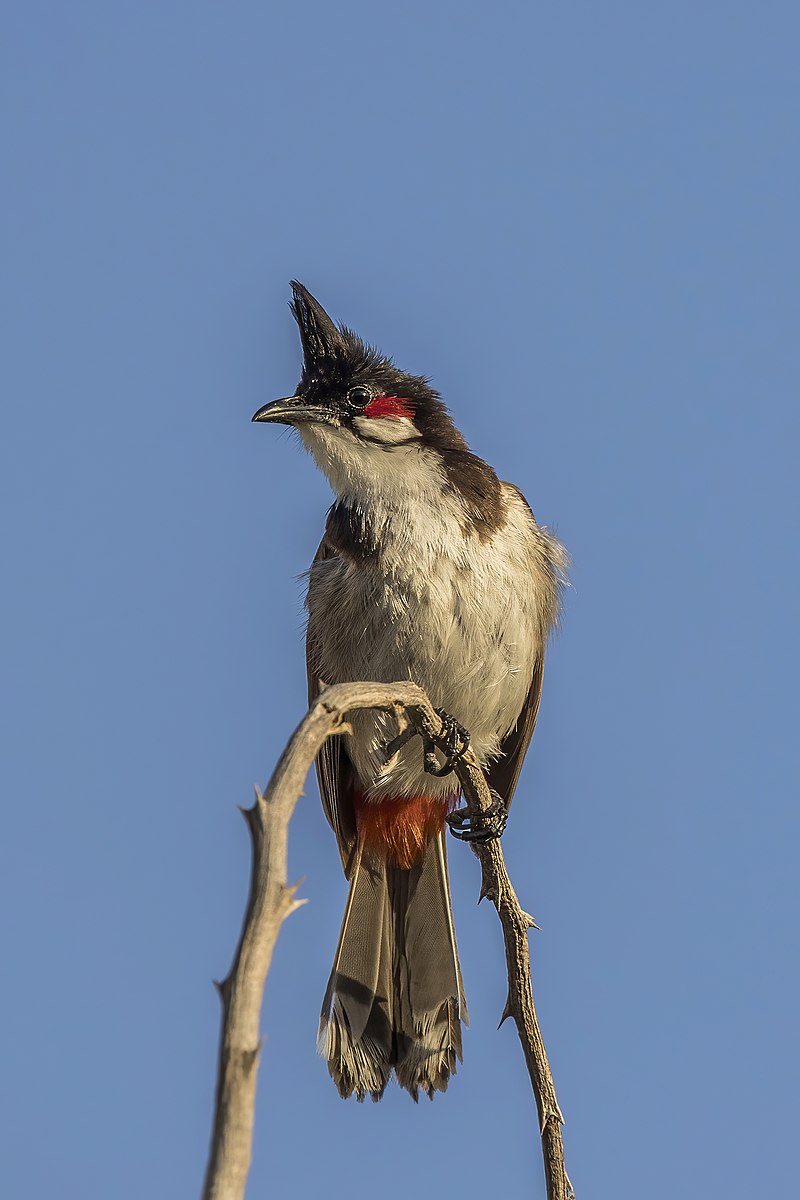
The Red-whiskered Bulbul is a passerine bird native to tropical Asia. It has an unmistakable black head, white cheek patch, and red whiskers on each side of its beak.
This brightly colored bulbul feeds mainly on fruits but also eats small insects from time to time.
The birds are known for their loud call which consists of three or four notes in succession and can often be heard emanating from treetops or other high perches where it likes to sit conspicuously.
Introductions have been made in many parts of the world outside its original range, with populations establishing themselves successfully in various locations including Hawaii and Florida within the United States.Scientific classification:
| Kingdom | Animalia |
| Phylum | Chordata |
| Class | Aves |
| Order | Passeriformes |
| Family | Pycnonotidae |
| Genus | Pycnonotus |
| Species | P. jocosus |
Also Featured In: Birds of Myanmar, Common Birds of Jharkhand
22. Oriental Pratincole
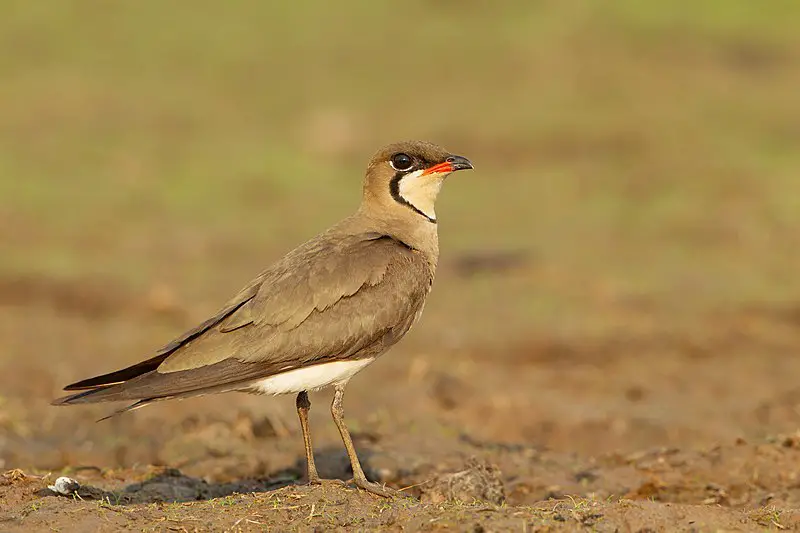
The Oriental Pratincole is a wader, belonging to the pratincole family Glareolidae. It has many names such as grasshopper-bird or swallow-plover, and its genus name comes from Latin glarea meaning ‘gravel’ due to their typical nesting habitats in gravel areas.
The species maldivarum refers to the type locality near Maldive Islands, where it was caught alive at sea.
This bird mainly feeds on terrestrial insects which gives it an advantage over other birds of prey that feed on marine animals only.
Its diet consists mostly of locusts as well as crickets and beetles among others; they hunt by either running fast or hovering above dry land before diving down for food items when spotted below them.
They have long wings combined with powerful flight muscles aid these birds during escape flights when pursued by predators like hawks or eagles since they are not very good fighters in aerial combat situations compared to other raptorsScientific classification:
| Kingdom | Animalia |
| Phylum | Chordata |
| Class | Aves |
| Order | Charadriiformes |
| Family | Glareolidae |
| Genus | Glareola |
| Species | G. maldivarum |
Also Featured In: Native South Korean Birds, Birds of Andhra Pradesh
23. Red-Throated Loon
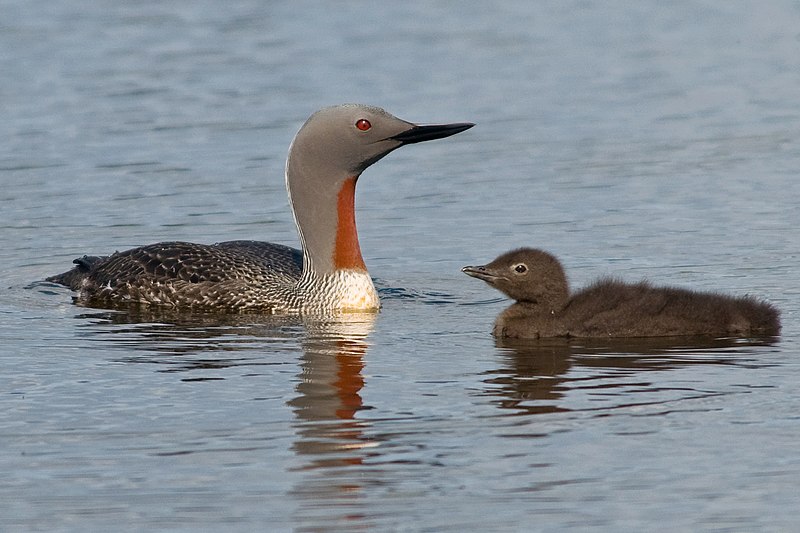
The Red-throated Loon is a migratory bird found in the northern hemisphere, with its breeding grounds primarily located in Arctic regions and wintering spots near coastal waters.
With an average length of 55 – 67 cm (22 – 26 inches), it’s the smallest member of the loon or diver family.
Its namesake comes from its bright red throat patch which contrasts against its white underside and grey back.
This species has adapted to life on icy seas; they are strong swimmers with powerful wings for long flights over open water when migrating seasonally.
Their diet consists mostly of fish but can also include crustaceans, molluscs, amphibians and insects depending on availability.Scientific classification:
| Kingdom | Animalia |
| Phylum | Chordata |
| Class | Aves |
| Order | Gaviiformes |
| Family | Gaviidae |
| Genus | Gavia |
| Species | G. stellata |
Also Featured In: Birds Live in Tunisia, Shetland Islands Birds You Should Know
24. Greater Painted-Snipe
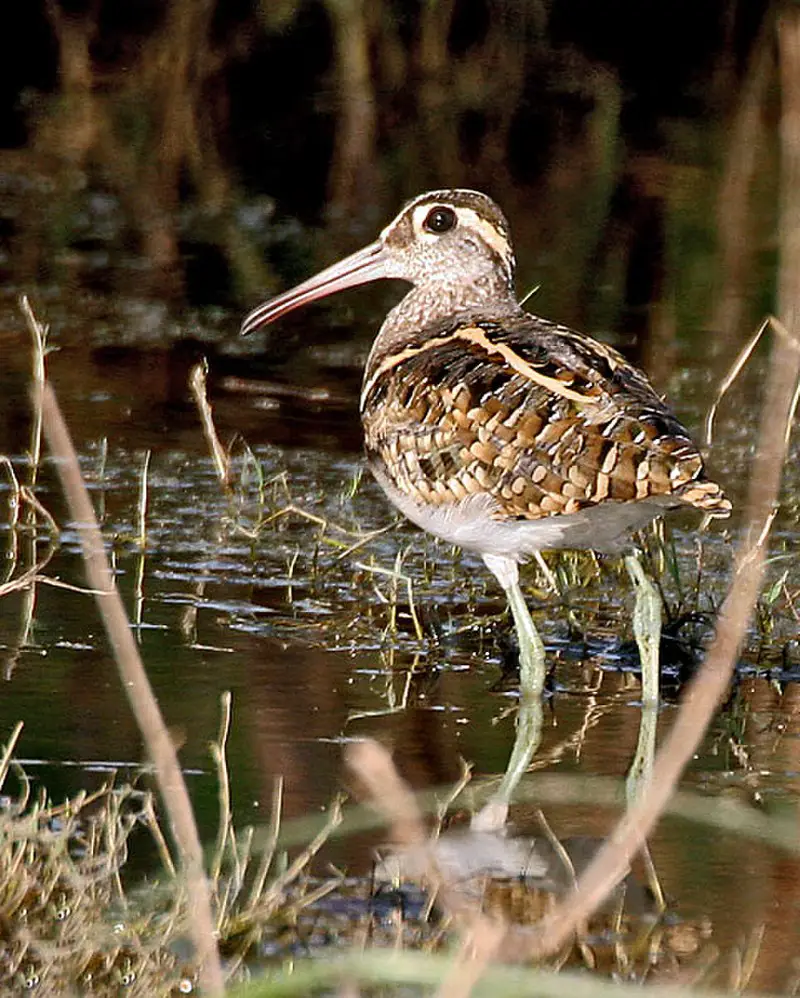
The Greater Painted-snipe is a medium-sized, plump wading bird found in marshes throughout Africa, South Asia and Southeast Asia.
It has distinctive features that make it stand out from its peers: a long reddish brown bill slightly curved at the tip with an eye patch of white or pinkish coloration; rounded wings speckled with buff spots; and a short tail.
The breast of this species has extensive white plumage which extends up around the top of its folded wing.
With its unique appearance, this avian beauty stands out among other birds in wetland habitats.Scientific classification:
| Kingdom | Animalia |
| Phylum | Chordata |
| Class | Aves |
| Order | Charadriiformes |
| Family | Rostratulidae |
| Genus | Rostratula |
| Species | R. benghalensis |
Also Featured In: Birds that Live in lake Mburo National Park, Birds Commonly Found in Kyoto
25. Chinese Penduline Tit
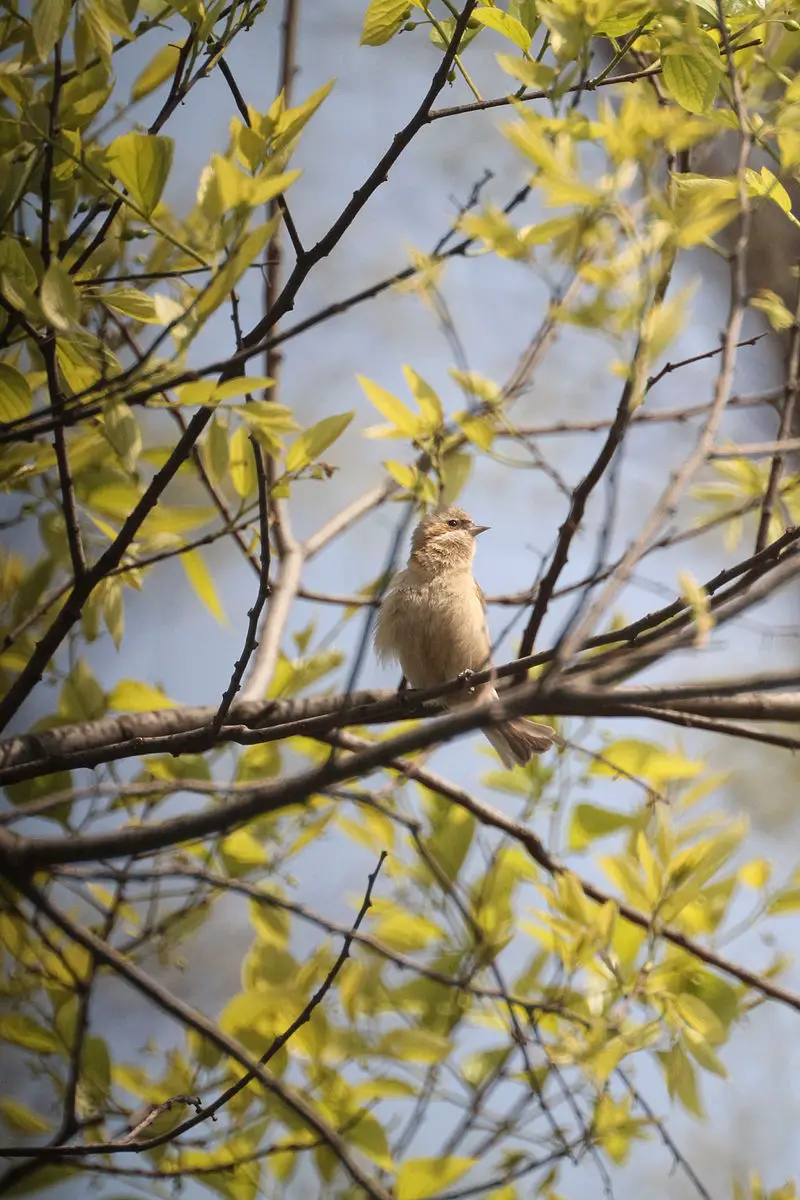
The Chinese penduline tit is a small bird belonging to the family Remizidae and was first described by Robert Swinhoe in 1870. It is found in China, Japan, North Korea, South Korea and Russia inhabiting open fields and wetlands.
This species has sharp bill tips which it uses for its characteristic of making pendulous nests usually from plant fibers or spider webs woven together.
The Chinese penduline tit belongs to ten different species within the family Remizidae that are similar but distinct from true tits due to their nesting behavior as well as other physical characteristics such as size differences between males and females .
Although they may be difficult to spot with their camouflaged colors blending into grassland environments , once spotted this distinctive bird can be easily identified by its unique nest building abilities.Scientific classification:
| Kingdom | Animalia |
| Phylum | Chordata |
| Class | Aves |
| Order | Passeriformes |
| Family | Remizidae |
| Genus | Remiz |
| Species | R. consobrinus |
26. Daurian Redstart
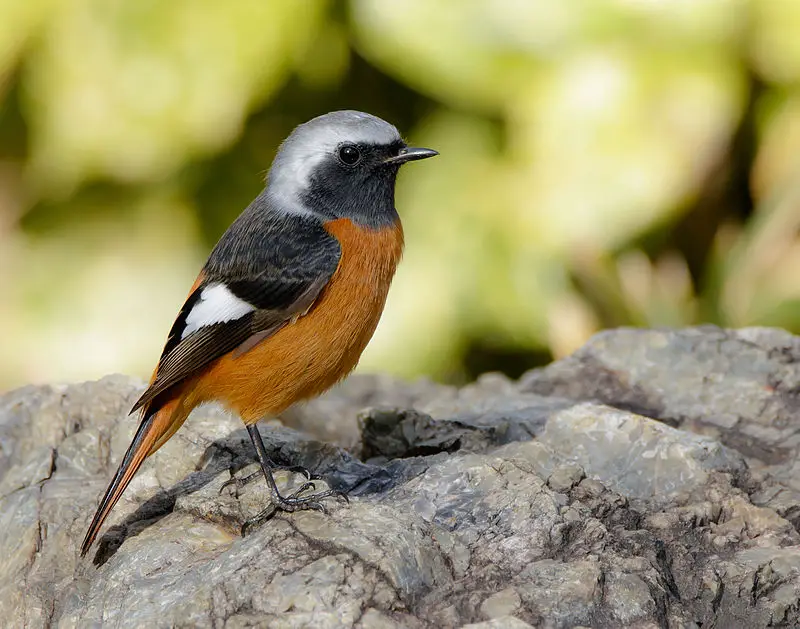
The Daurian redstart is a small passerine bird that inhabits temperate Asia. It was first described by Peter Simon Pallas in 1776 and has an average length of 14-15 cm with weights ranging from 11-20 g.
As typical for the species, males and females are strongly sexually dimorphic; male breeding birds have grey crowns, napes, lighter foreheads and crown sides.
The back feathers are brownish black while their underparts display bright orange colouring on chest and belly area, as well as white outer tail feathers, tipped in black or reddish brown.
Female Breeding individuals feature more muted colors – light gray heads to dull yellow chests alongside dark barred wings and tails also having contrasting white tips at the end of them.
This beautiful creature can often be seen perched atop tree branches near open areas such as riversides or meadows where it searches for food like insects which make up most of its diet along with some berries occasionally being eaten tooScientific classification:
| Kingdom | Animalia |
| Phylum | Chordata |
| Class | Aves |
| Order | Passeriformes |
| Family | Muscicapidae |
| Genus | Phoenicurus |
| Species | P. auroreus |
Also Featured In: Yakushima Island Birds You Should Know,
27. Glossy Ibis
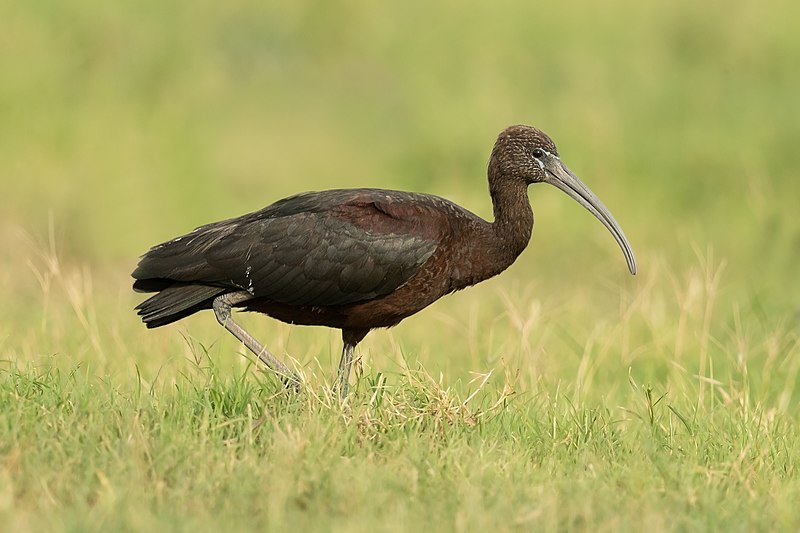
The Glossy Ibis is a water bird that belongs to the family Threskiornithidae. It has an unique bill in the shape of a sickle, which gave it its scientific name – Plegadis falcinellus.
It can be found widely across Europe, Asia and Africa, with scattered nesting sites in warm regions.
Its feathers are black-brown on top and chestnut brown from below; their wings have glossy greenish-purple sheen when seen from afar.
They mainly feed on small insects like grasshoppers, spiders or earthworms as well as crustaceans or amphibians caught while wading through shallow waters.
During breeding season they also consume plant material such as rice grains or corn kernels provided by humans near habitat areas where they nest.Scientific classification:
| Kingdom | Animalia |
| Phylum | Chordata |
| Class | Aves |
| Order | Pelecaniformes |
| Family | Threskiornithidae |
| Genus | Plegadis |
| Species | P. falcinellus |
Also Featured In: Uganda Birds Species, Bulgarian Birds
28. Buttonquail
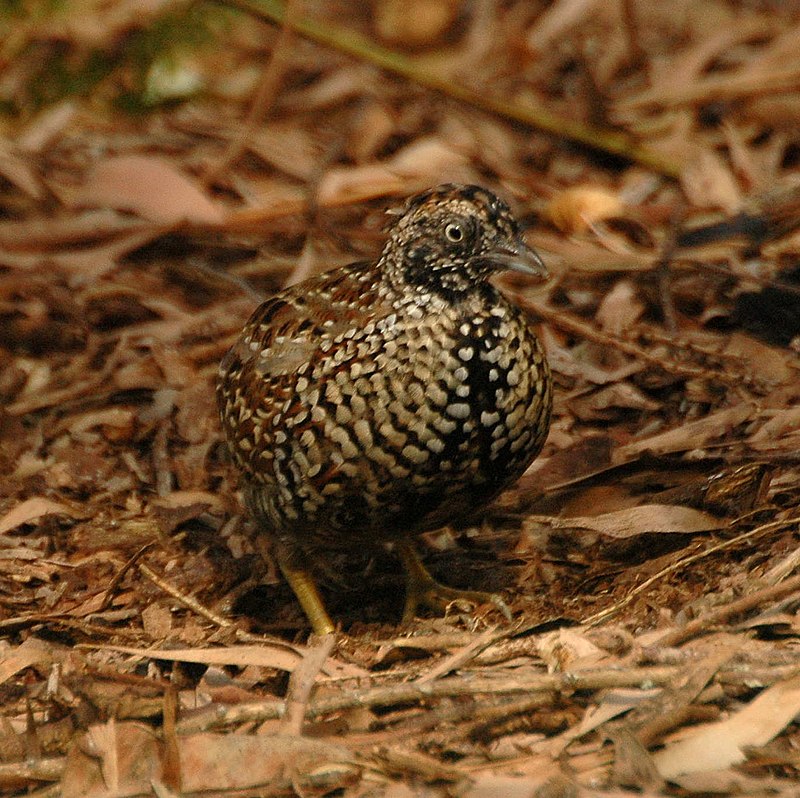
Buttonquails are small, terrestrial birds belonging to the family Turnicidae. They can be found in warm grasslands of Asia, Africa, Europe and Australia.
There are 18 species found across two genera; most being placed under the genus Turnix with a single species known as Ortyxelos.
These birds share a superficial resemblance to quail from Phasianidae but lack any close relation.
Buttonquails avoid flying and instead prefer running on their short legs for navigational purposes.
In terms of physicality they have drab colouring which comprises mostly browns or greys whilst sporting distinctive white patches around their eyes making them easy to identify within dense foliage areas where they usually hide away during times of danger or distress.Scientific classification:
| Kingdom | Animalia |
| Phylum | Chordata |
| Class | Aves |
| Order | Charadriiformes |
| Family | Turnicidae GR Gray, 1840 |
Also Featured In: Birds of Morocco, Birds that Live around Victoria
29. Black-Winged Kite
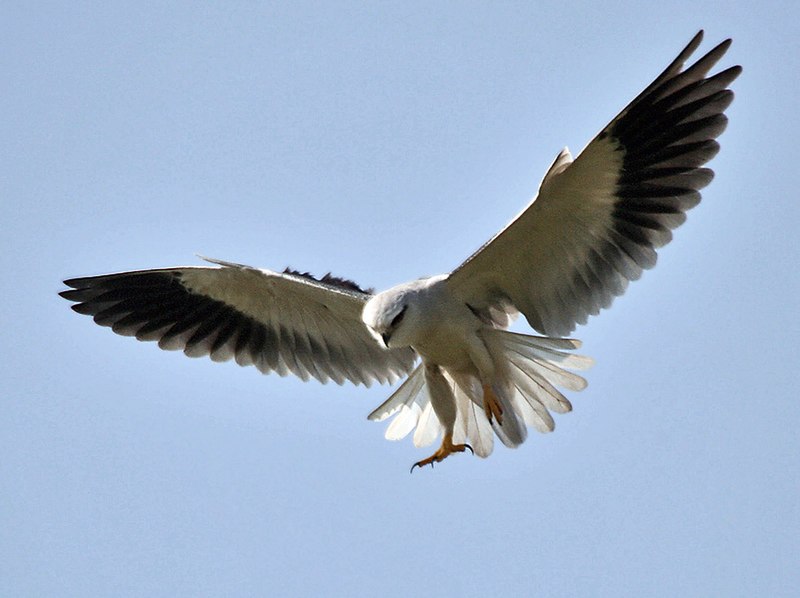
The Black-winged Kite is a small, diurnal bird of prey in the Accipitridae family. It can be found throughout Palearctic and Afrotropical regions.
This species stands out from other birds of prey due to its unique ability to hover over open grasslands like kestrels do.
Its wings are black with white patches on them while its body has gray feathers, giving it a distinct look from the rest of the accipiters.
The underside is mostly white with some barring near the tail area that helps distinguish this species from others.
They feed mainly on insects but will also eat rodents, lizards and even snakes if they come across one.
Because these birds hunt during daylight hours, their diet changes as time passes by – making them quite adaptive hunters.Scientific classification:
| Kingdom | Animalia |
| Phylum | Chordata |
| Class | Aves |
| Order | Accipitriformes |
| Family | Accipitridae |
| Genus | Elanus |
| Species | E. caeruleus |
Also Featured In: Birds Of Côte d’Ivoire, Common Birds of Portugal
30. Black-Winged Stilt
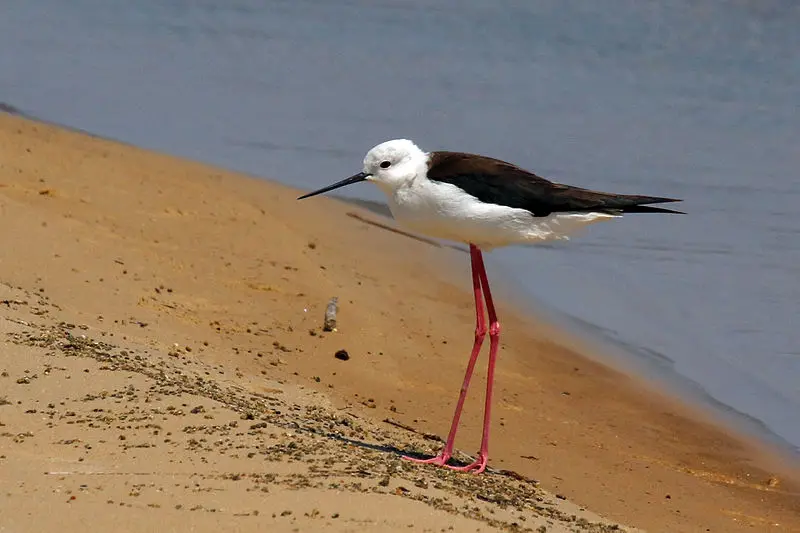
The Black-winged Stilt is a wading bird that belongs to the avocet and stilt family. It has very long legs, making it well adapted for standing in shallow water while searching for food like small fish and insects.
Its scientific name Himantopus himantopus can be applied either to one cosmopolitan species or the form found across Europe, Asia and Africa which equals its nominate group.
Generally this species is black on top with an all white underside but it also features red eyes with a thin white ring around each one as well as black wings flecked with white feathers towards the tips of their wings.Scientific classification:
| Kingdom | Animalia |
| Phylum | Chordata |
| Class | Aves |
| Order | Charadriiformes |
| Family | Recurvirostridae |
| Genus | Himantopus |
| Species | H. himantopus |
Also Featured In: Birds of Senegal, Fuerteventura Island Birds You Need to See
31. Dalmatian Pelican
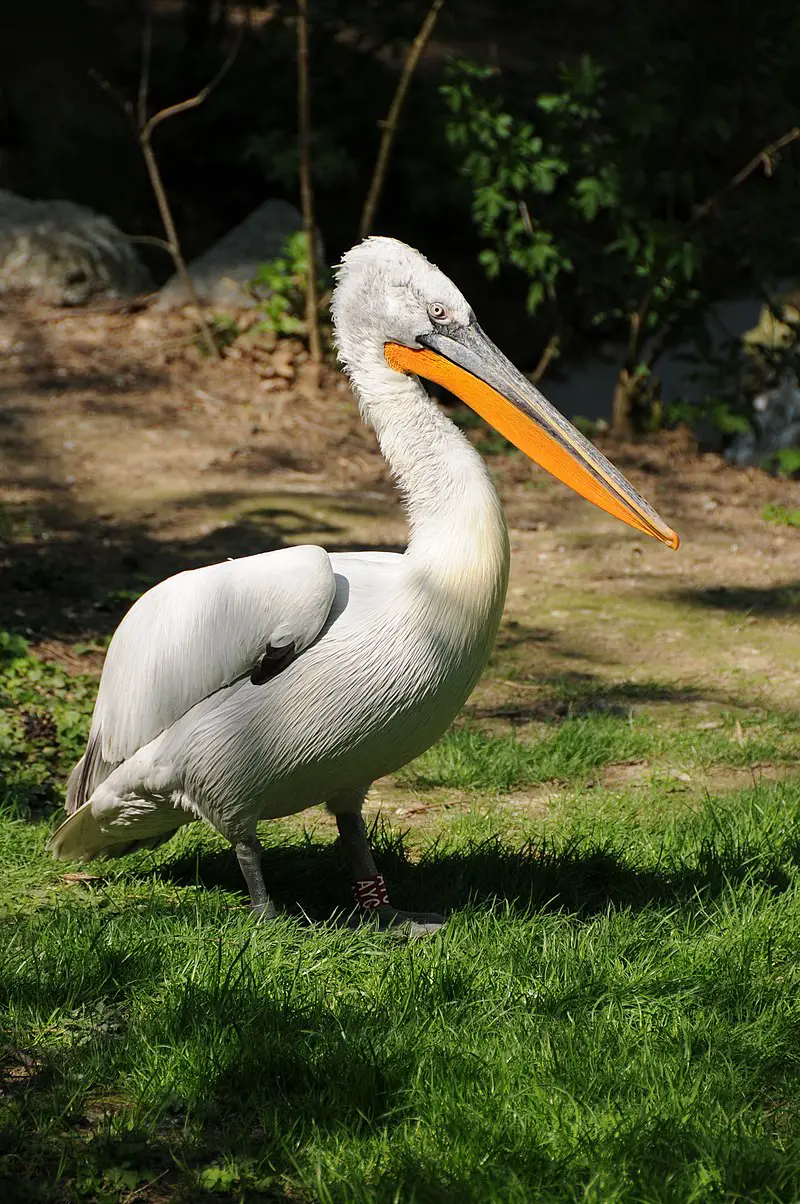
The Dalmatian pelican is an impressive bird, the largest of its family and one of the largest freshwater birds in the world.
Its wingspan rivals even those of albatrosses and it flies gracefully with other members in synchrony.
It has a wide range across Central Eurasia stretching from Mediterranean to India and Southeast Asia, as well as parts of Russia.
This large species has white feathers which are generally lightly tinged with grey or yellow around their head; they have long beaks that can reach up to 40cm in length.
Their unique physical characteristics make them stand out among other waterbirds – so if you ever get lucky enough to spot one while exploring nature, take some time to appreciate this majestic creature.Scientific classification:
| Kingdom | Animalia |
| Phylum | Chordata |
| Class | Aves |
| Order | Pelecaniformes |
| Family | Pelecanidae |
| Genus | Pelecanus |
| Species | P. crispus |
Also Featured In: Most Beautiful birds of Greece, Most Common Romanian Birds
32. Drongos
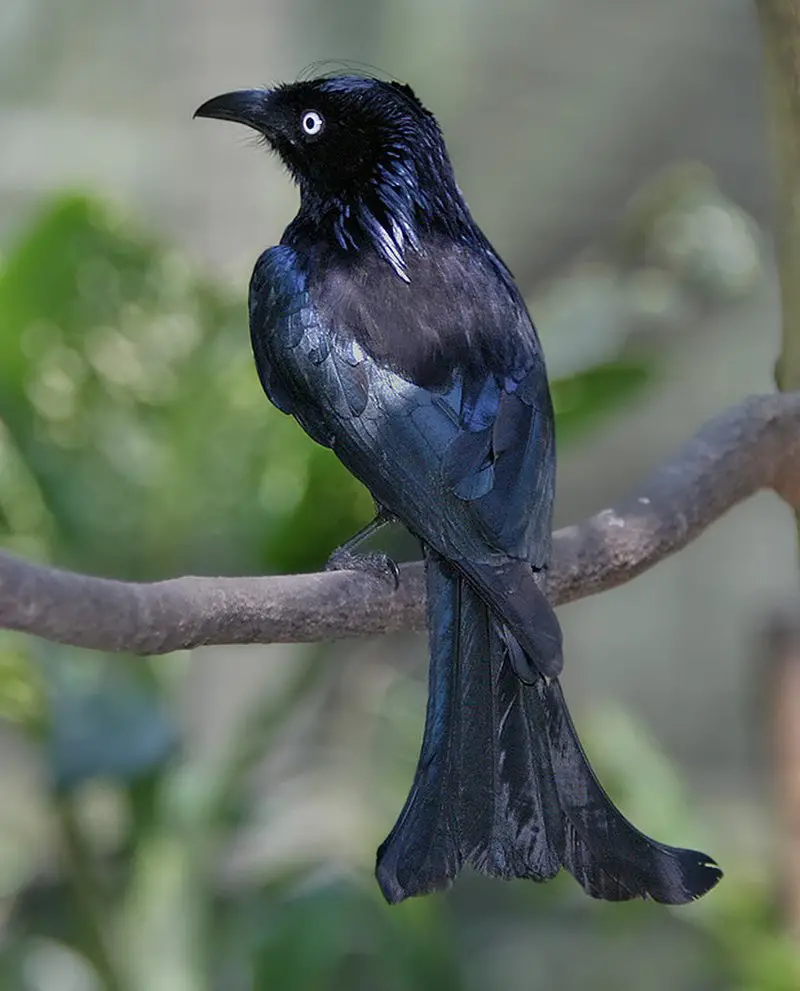
Drongos are an Old World tropical family of passerine birds belonging to the Dicruridae genus.
They have short legs, forked tails and a distinctive upright stance when perched.
Depending on the species they may be mostly black or dark grey in colour with some having elaborate tail decorations.
Drongos feed mainly on insects and small birds – catching them both in flight and from the ground.
They also sometimes eat fruit, nectar and even carcasses.
The drongo’s unique adaptations make it one of nature’s most successful hunters; able to survive almost anywhere in their natural range across Africa, Asia & Australia.Scientific classification:
| Kingdom | Animalia |
| Phylum | Chordata |
| Class | Aves |
| Order | Passeriformes |
| Superfamily | Corvoidea |
| Family | Dicruridae Vigors, 1825 |
| Genus | Dicrurus Vieillot, 1816 |
Also Featured In: Birds of United Arab Emirates, Asian Birds
33. Eurasian Whimbrel
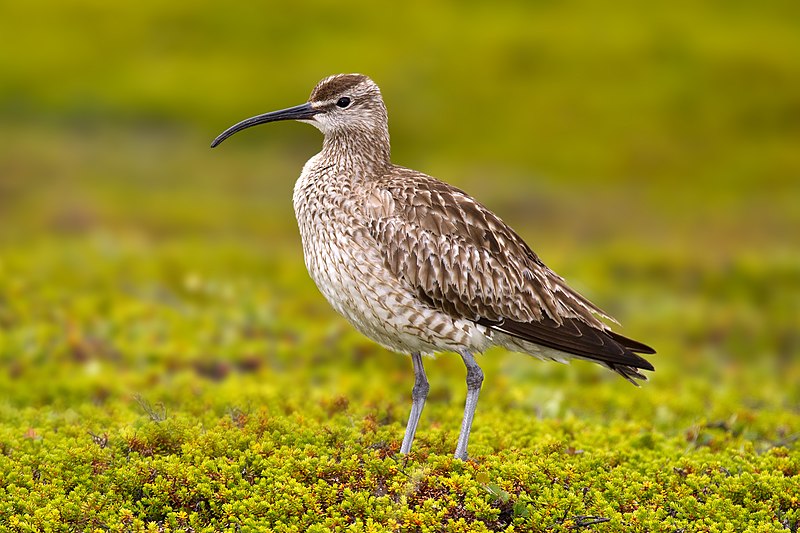
Eurasian Whimbrels are a species of wading bird commonly found in subarctic regions of Europe and Asia.
They have white rumps, long curved bills, brown wings and backs with light streaking on the lower breast.
These birds feed mainly on crustaceans, mollusks or worms they find while probing in the mud during low tide.
During breeding season they can be seen nesting near coastal areas or wetlands where food is plentiful.
This species has recently been split from Hudsonian whimbrels but some authorities still consider them to be one species due to their similarities which includes migration patterns as well as habitat preferences.
Eurasian whimbrels are an important part of many ecosystems because they help control insect populations by eating larvae before it can cause damage to crops or vegetation nearby.Scientific classification:
| Kingdom | Animalia |
| Phylum | Chordata |
| Class | Aves |
| Order | Charadriiformes |
| Family | Scolopacidae |
| Genus | Numenius |
| Species | N. phaeopus |
Also Featured In: Singapore Birds, Galapagos Birds You Should Know
34. Spotted Redshank
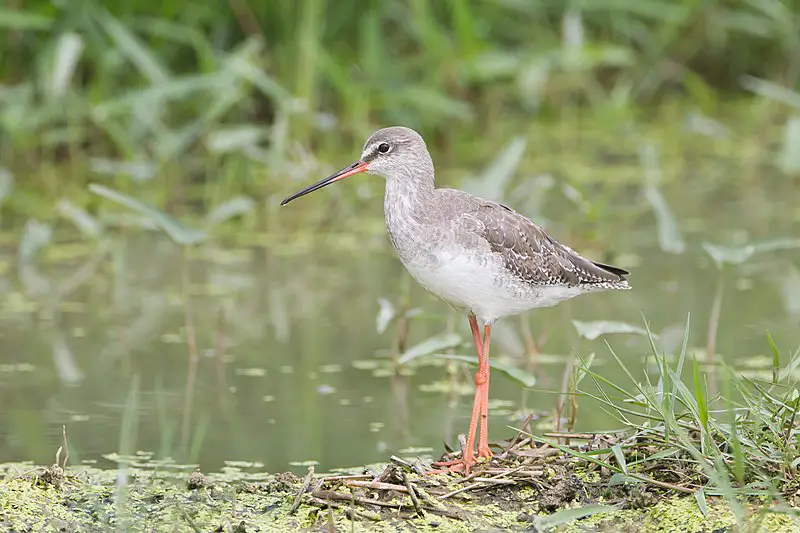
The Spotted Redshank is a shorebird belonging to the Scolopacidae family. Its genus name, Tringa, comes from Ancient Greek trungas and its specific erythropus refers to the red color of its feet.
This species can be found in wetlands across Europe and Asia during migratory periods but it primarily breeds in Northern Scandinavia.
It has a black body with white spots over its wings and neck while also having long yellow legs which help them wade through shallow waters looking for food such as insects, small fish, worms or mollusks.
Although they are not currently considered endangered they have experienced population declines due to changes in their habitat caused by human activities like pollution or coastal drainage projects.Scientific classification:
| Kingdom | Animalia |
| Phylum | Chordata |
| Class | Aves |
| Order | Charadriiformes |
| Family | Scolopacidae |
| Genus | Tringa |
| Species | T. erythropus |
Also Featured In: Norway Birds,
35. Yellow-Crested Cockatoo
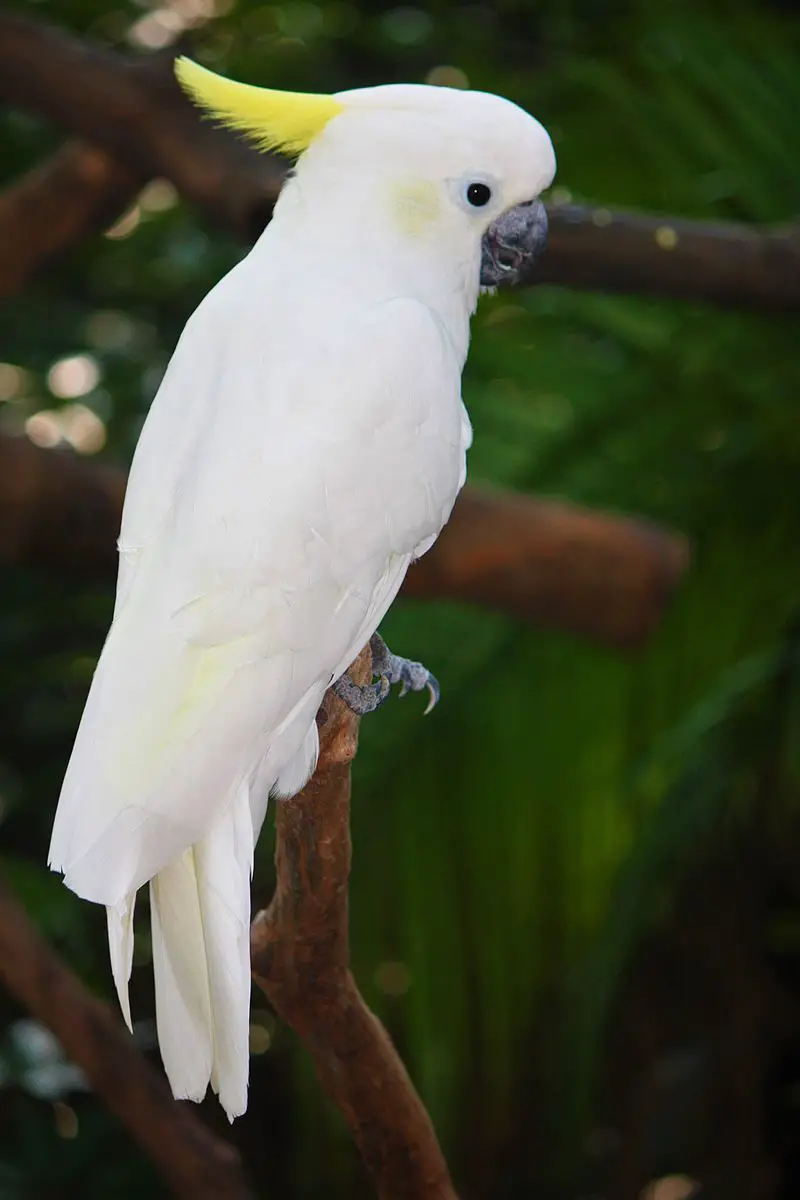
The Yellow-crested Cockatoo is a beautiful and striking bird that can be found in East Timor and the Sula Islands of Indonesia.
It has white plumage, bluish-white bare orbital skin, grey feet, a black bill and an impressive retractile yellow or orange crest.
These birds stand at around 34 cm long which makes them medium sized amongst cockatoos.
They prefer to live in wooded areas as well as cultivated land but are unfortunately endangered due to habitat loss from deforestation along with illegal trapping for pet trade purposes.
They have been listed under CITES Appendix I since 1981 meaning all activities involving international commercial trading of these birds must cease immediately if they are ever going to make a full recovery within their natural habitats again.Scientific classification:
| Kingdom | Animalia |
| Phylum | Chordata |
| Class | Aves |
| Order | Psittaciformes |
| Family | Cacatuidae |
| Genus | Cacatua |
| Subgenus | Cacatua |
| Species | C. sulphurea |
Also Featured In: Timor-Leste birds, Big Birds that Live in Singapore
36. White-Tailed Tropicbird
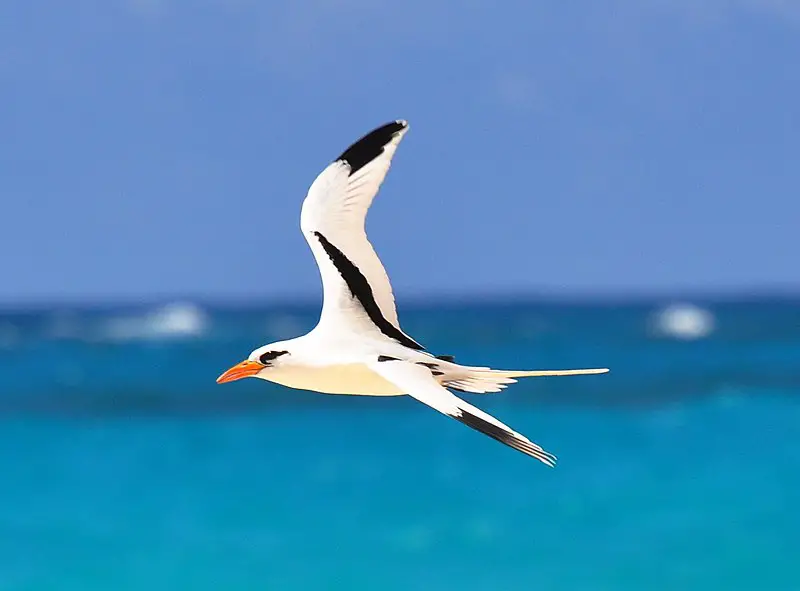
The White-tailed Tropicbird is a beautiful seabird that lives in the tropical waters of the Atlantic, Pacific, and Indian Oceans.
It is the smallest member of its order Phaethontiformes, measuring only 28 inches from head to tail.
Its wingspan can reach up to 45 inches wide. The bird has white plumage with black markings on its wings and tail feathers.
It also has an unmistakable long streamer which trails out behind them when they are in flight – a characteristic feature for all tropicbirds.
They nest mainly on remote islands throughout their range but have recently begun nesting on Little Tobago as well.
These birds feed primarily off flying fish or squid near the ocean’s surface during daylight hours before returning back home at nightfall.Scientific classification:
| Kingdom | Animalia |
| Phylum | Chordata |
| Class | Aves |
| Order | Phaethontiformes |
| Family | Phaethontidae |
| Genus | Phaethon |
| Species | P. lepturus |
Also Featured In: Mauritius birds, Birds You’ll Find in the Sea
37. Bulwer’s Petrel
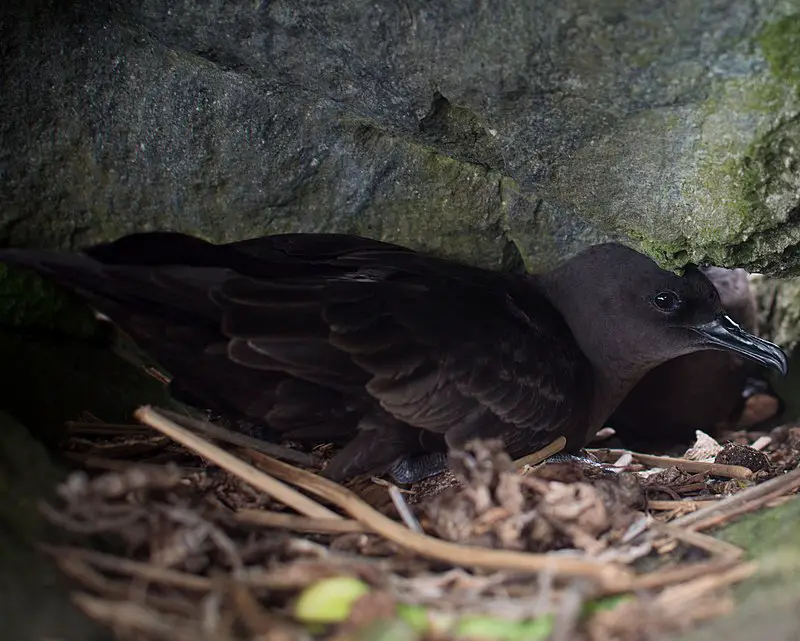
Bulwer’s petrel is a small seabird in the Procellariidae family which can be found across tropical and subtropical regions of the Atlantic, Indian and Pacific Oceans.
It was named after English naturalist James Bulwer who first described it in 1828 along with Jardine and Selby.
The bird has dark greyish plumage on its back while the underside is typically white or pale grey.
Its wings are short but broad making them ideal for soaring high above large bodies of water looking for food such as squid, fish, crustaceans and insects.
They use their long pointed bill to catch prey from both surface-skimming dives or underwater plunges up to 15 meters deep.
These birds nest burrows dug into soil cliffs where they lay just one egg each year which takes about 55 days to hatch.Scientific classification:
| Kingdom | Animalia |
| Phylum | Chordata |
| Class | Aves |
| Order | Procellariiformes |
| Family | Procellariidae |
| Genus | Bulweria |
| Species | B. bulwerii |
Also Featured In: Cabo Verde birds, Birds that Live in the Ocean
38. Brown Shrike
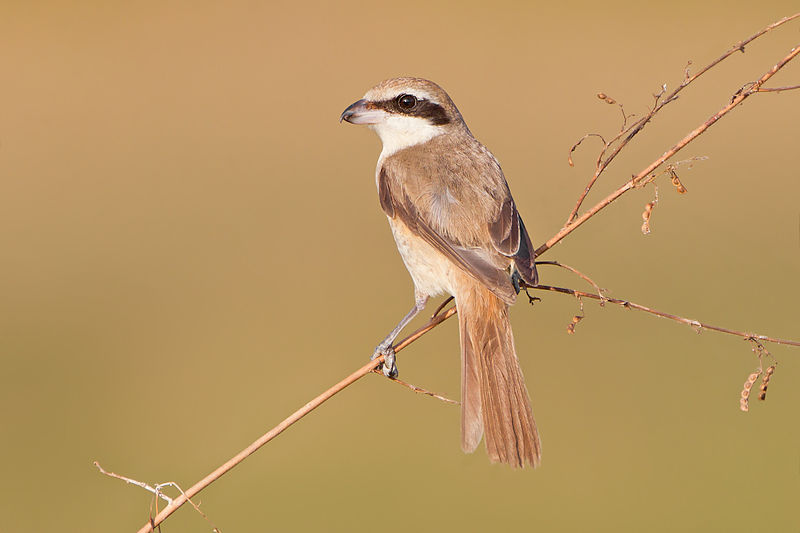
The Brown Shrike is a beautiful bird belonging to the shrike family, found mainly in Asia. It has a distinctive crest which gives it its Latin name ‘cristatus’.
They feed on insects and small vertebrates like lizards and mice, hence they are also called ‘butcher birds’.
These birds have brown upperparts with rufous wings, tail tipped white along with black mask through the eyes giving them an impressive look.
Despite their predatory nature these birds still remain quite popular amongst birdwatchers due to their vibrant colors and wide-ranging habitats across much of South East Asia making them easy targets for photography enthusiasts too.Scientific classification:
| Kingdom | Animalia |
| Phylum | Chordata |
| Class | Aves |
| Order | Passeriformes |
| Family | Laniidae |
| Genus | Lanius |
| Species | L. cristatus |
Also Featured In: Maldives birds, Most Common Birds of Bihar
39. Ancient Murrelet
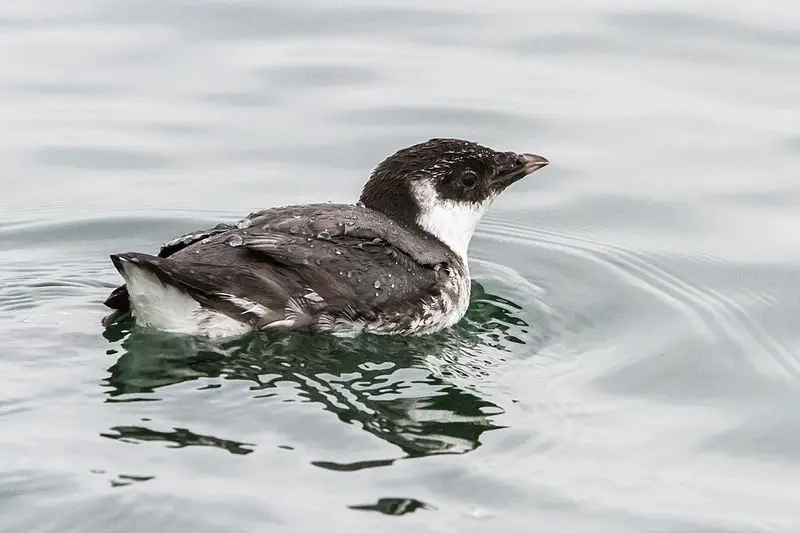
The Ancient Murrelet is a small seabird in the Auk family. This species has an unmistakable appearance, with its grey shawl-like back and white underparts.
It can also be identified by its call which resembles that of a common guillemot. The origin of their name remains uncertain but it may come from this distinctive sound they make when communicating with others.
They are found mainly around the coastal waters of North Pacific Ocean, particularly off parts of Alaska and Canada where food sources abound for them to feed on such as fish, molluscs and planktonic crustaceans.
These birds form large breeding colonies during springtime so they can protect themselves against predators more effectively while raising their young ones until independence comes at 6 weeks old.Scientific classification:
| Kingdom | Animalia |
| Phylum | Chordata |
| Class | Aves |
| Order | Charadriiformes |
| Family | Alcidae |
| Genus | Synthliboramphus |
| Species | S. antiquus |
Also Featured In: Auks Species, Urban Birds of Hong Kong
40. Eurasian Tree Sparrow
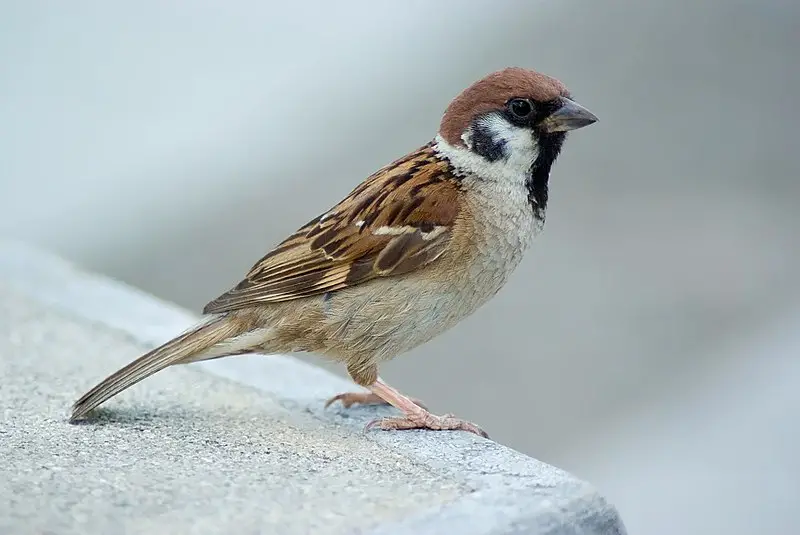
The Eurasian tree sparrow is a passerine bird in the sparrow family, easily recognizable by its chestnut crown and nape as well as black cheek patches.
Both males and females have similar plumage, while young birds appear duller than adults.
This species has an extensive range covering most of temperate Eurasia and Southeast Asia where it goes by the name ‘tree sparrow’.
It has also been introduced to other countries outside these regions. The bird feeds on grains, fruits and insects with preference for open areas near human settlements such as farmland or villages.
They are social creatures that can be found in small flocks all year round but do not migrate long distances like some species of their kind.Scientific classification:
| Kingdom | Animalia |
| Phylum | Chordata |
| Class | Aves |
| Order | Passeriformes |
| Family | Passeridae |
| Genus | Passer |
| Species | P. montanus |
Also Featured In: Sparrows Species,
41. Little Grebe
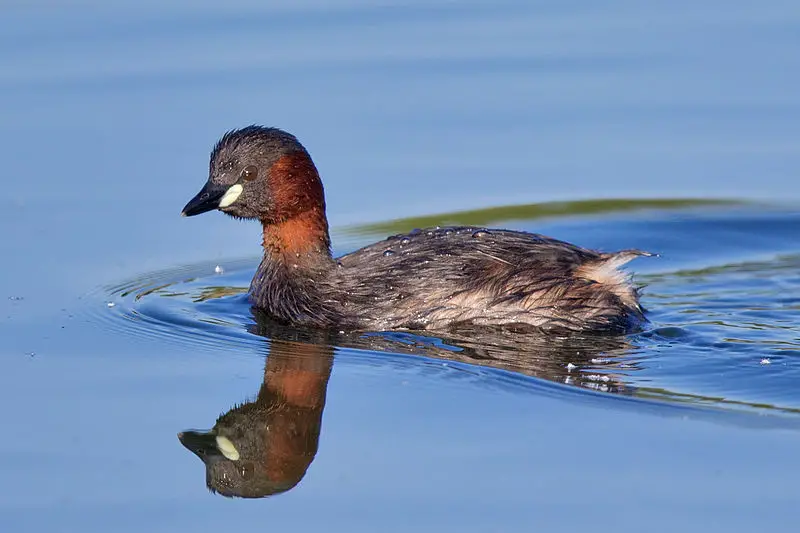
The little grebe, also known as dabchick, belongs to the grebe family and is a small water bird. It gets its genus name from the Ancient Greek words for ‘fast’ and ‘to sink under’.
The specific name ruficollis means ‘red-necked’ in Latin. With a length of 23 to 29 centimetres, it is the smallest member of the grebe family.Scientific classification:
| Kingdom | Animalia |
| Phylum | Chordata |
| Class | Aves |
| Order | Podicipediformes |
| Family | Podicipedidae |
| Genus | Tachybaptus |
| Species | T. ruficollis |
Also Featured In: Turkey Birds You Should Know, Italian Birds You Should Know
42. Pied Avocet
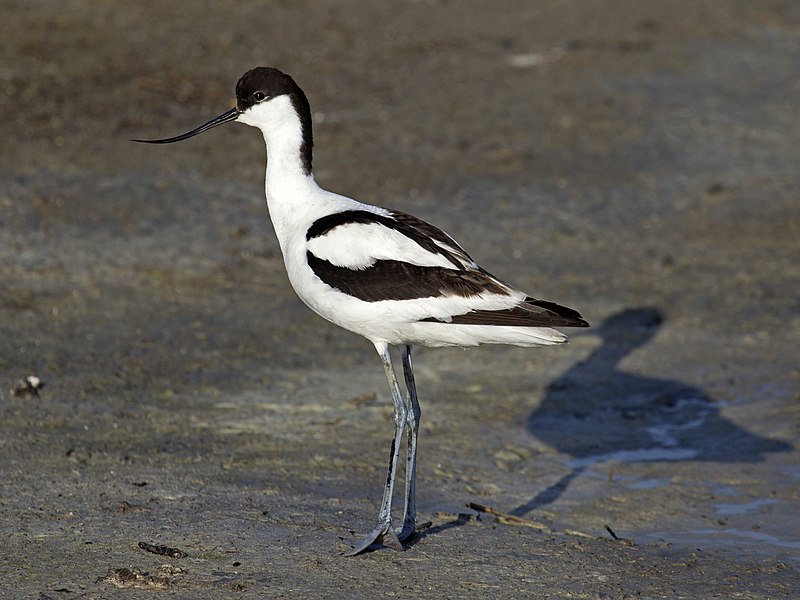
The pied avocet is a distinctive wader bird, easily recognized by its black and white plumage and upturned bill.
Found in temperate Europe and the Palearctic region, these birds migrate to Africa or southern Asia for the winter.
However, some of them can stay in the southern part of their breeding range. These birds are known for their distinctive feeding behavior, where they sweep their bills side to side through shallow water to locate prey.
They mainly feed on aquatic invertebrates, such as insects and crustaceans.
The pied avocet can be found in a range of wetland habitats, including coastal lagoons, estuaries, and shallow lakes.
They breed in colonies and make nests on the ground, which are often located on islands or raised mounds.
These birds are considered to be of least concern for conservation, although habitat loss and disturbance can pose a threat to their populations.Scientific classification:
| Kingdom | Animalia |
| Phylum | Chordata |
| Class | Aves |
| Order | Charadriiformes |
| Family | Recurvirostridae |
| Genus | Recurvirostra |
| Species | R. avosetta |
Also Featured In: Black And White Birds You Don’t Know About, Common Birds of Lesbos Island
43. Scarlet Minivet
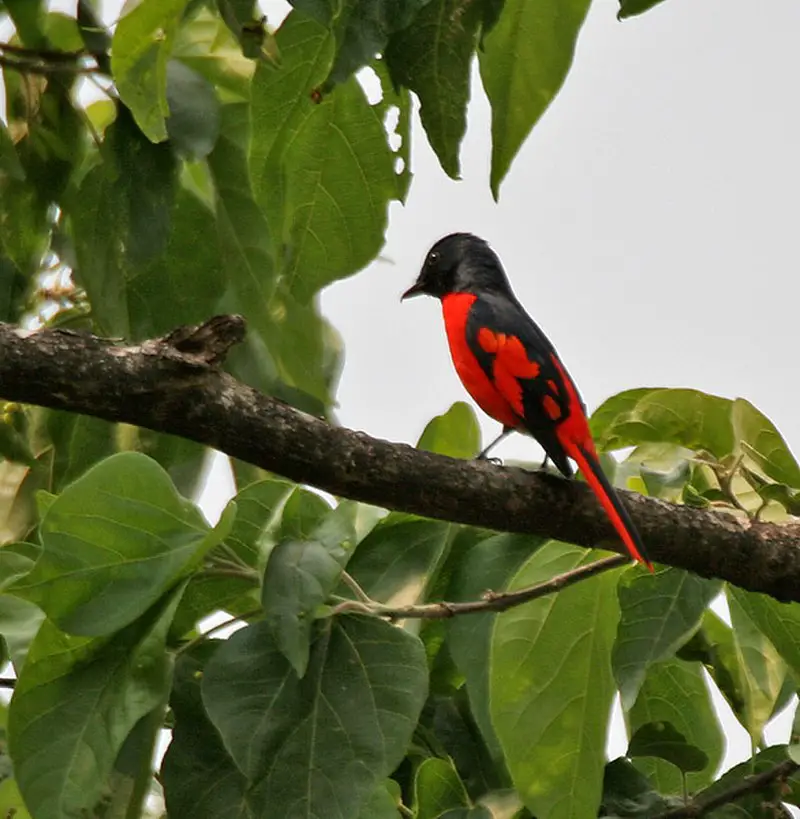
The Scarlet Minivet is a tiny bird species that is commonly found in tropical regions of southern Asia. It is a resident breeding bird and prefers well-wooded habitats like forests and gardens.
The male species has a bright orange or scarlet color with a black upper part. It is a common sight in hilly regions of Northeast India to southern China, Indonesia, and the Philippines.
The bright color of the male makes it easy to identify this species when compared to the female, whose coloring is not as vibrant.
Scarlet Minivets can often be heard singing their melodious songs in the forests, making them a favorite among birdwatchers.Scientific classification:
| Kingdom | Animalia |
| Phylum | Chordata |
| Class | Aves |
| Order | Passeriformes |
| Family | Campephagidae |
| Genus | Pericrocotus |
| Species | P. speciosus |
Also Featured In: Common Birds that Live in Odisha, Birds You’ll Find in Kanha National Park
44. Great Barbet
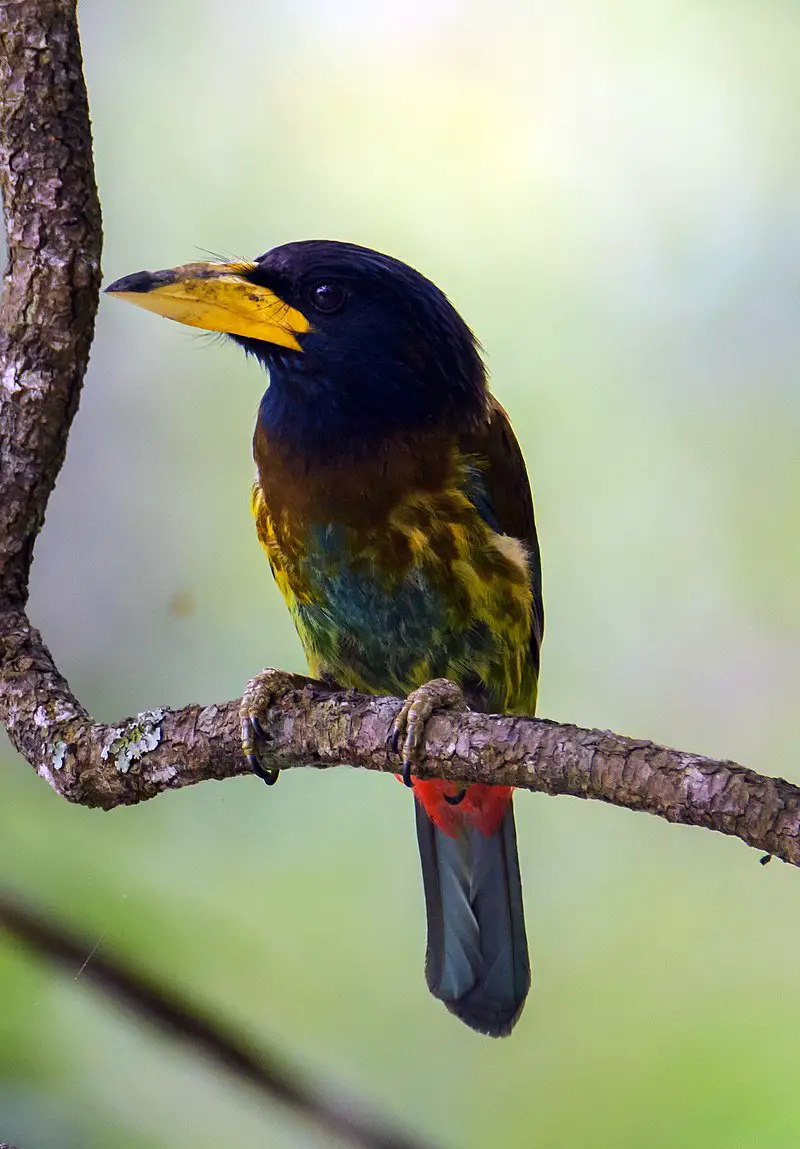
The Great Barbet is a bird species that is indigenous to the Indian subcontinent and Southeast Asia. It mainly resides in forests situated up to 3,000 meters above sea level.
This bird has an attractive and colorful appearance and is a common sight in the region. Its scientific name was suggested as Bucco virens in 1783 by Pieter Boddaert.
Despite being listed as Least Concern on IUCN’s Red List, these birds still face threats from habitat loss and hunting.
The Great Barbet’s wide distribution across its natural range allows it to survive and continue to thrive, making it an important part of the region’s ecosystem.Scientific classification:
| Kingdom | Animalia |
| Phylum | Chordata |
| Class | Aves |
| Order | Piciformes |
| Family | Megalaimidae |
| Genus | Psilopogon |
| Species | P. virens |
Also Featured In: Birds that Live in Uttarakhand, Birds that Commonly Found in Andhra Pradesh
45. Mountain Tailorbird
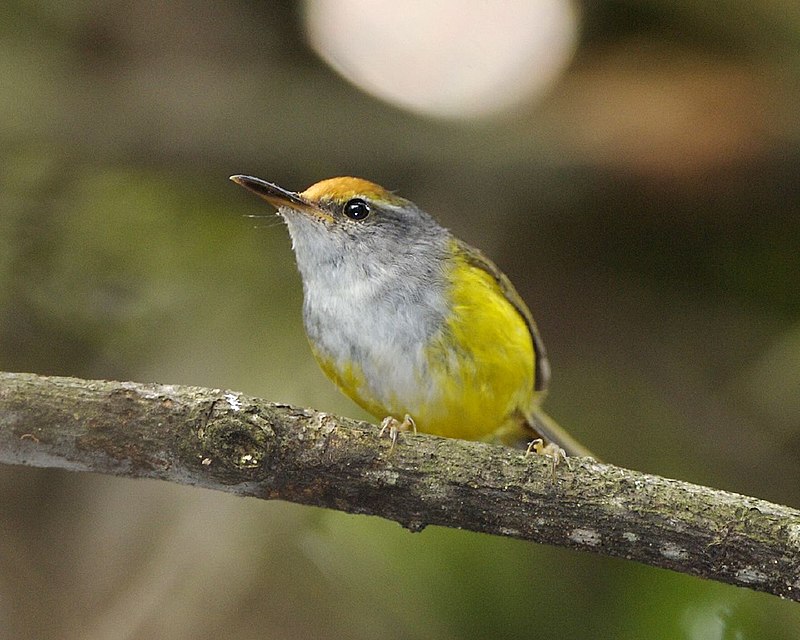
The mountain tailorbird is a small songbird that can be found in various countries in Asia including Bangladesh, India, and Indonesia.
Formerly part of the “Old World warbler” group, it is now classified under the genus Phyllergates and the family Cettiidae.
Its natural habitats are moist lowland forests in subtropical or tropical regions. This bird is known for its distinctive and complex songs.
Despite being widespread across its range, there is limited information available on its population status and conservation needs.
The mountain tailorbird is a fascinating species that adds to the rich biodiversity of the Asian continent.Scientific classification:
| Kingdom | Animalia |
| Phylum | Chordata |
| Class | Aves |
| Order | Passeriformes |
| Family | Cettiidae |
| Genus | Phyllergates |
| Species | P. cucullatus |
Also Featured In: Palawan Island Birds,
46. Grey-Chinned Minivet
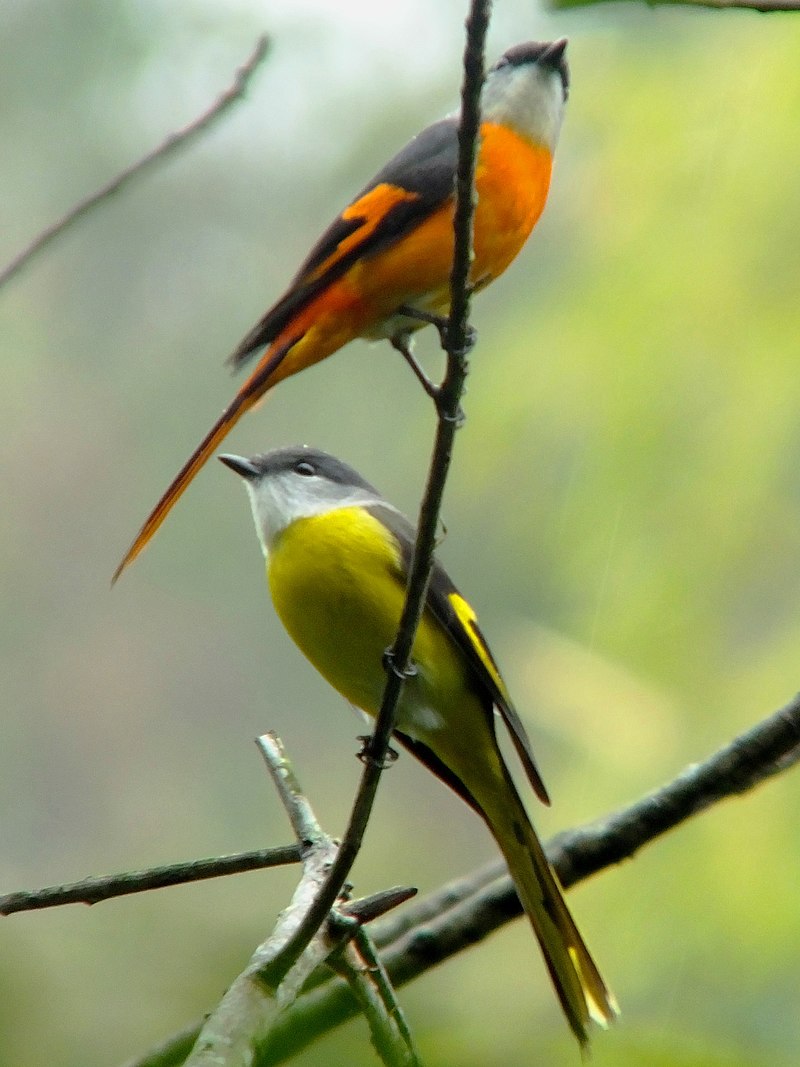
The Grey-chinned minivet is a bird species belonging to the Campephagidae family. It can be found in various regions, including China, Taiwan, and Southeast Asia, and is commonly spotted in forests around 1,000 to 2,000 meters above sea level.
This bird has a distinct grey chin and is a sight to behold when seen flying about.
Despite habitat loss and human encroachment, the species has been classified as a least-concern species by the International Union for Conservation of Nature (IUCN).
The bird was first described from Darjeeling by Edw and has been studied for behavioral patterns and migratory habits.
The Grey-chinned minivet is a beautiful and resilient bird species that continues to thrive in natural habitats across countries.Scientific classification:
| Kingdom | Animalia |
| Phylum | Chordata |
| Class | Aves |
| Order | Passeriformes |
| Family | Campephagidae |
| Genus | Pericrocotus |
| Species | P. solaris |
47. Mrs. Gould’s Sunbird
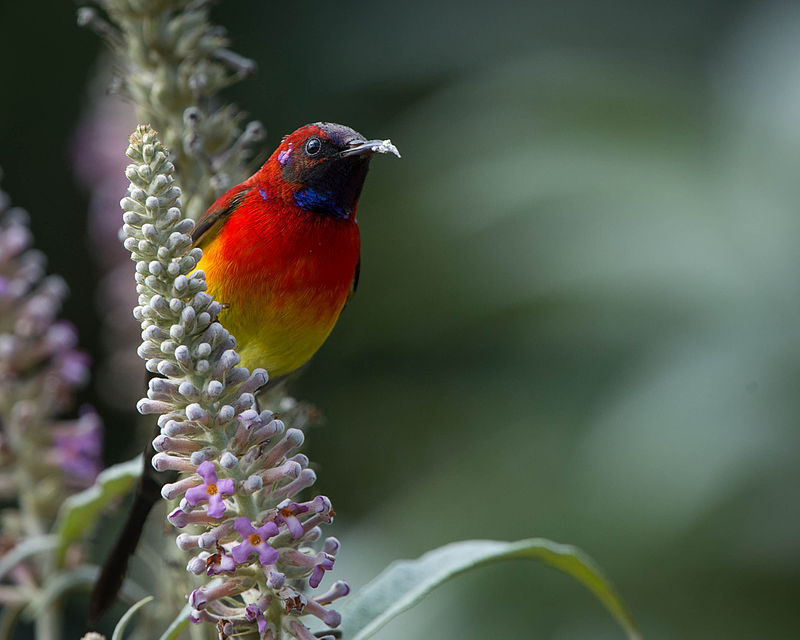
Mrs. Gould’s sunbird is a brightly colored bird species found in forests and shrublands across Southeast Asia and the southern foothills of the Himalayas.
It was named after British bird artist Elizabeth Gould by Irish zoologist Nicholas Vigors in 1831. The species is closely related to other sunbird species and four subspecies have been described.
With its vivid colors and distinctive plumage, Mrs. Gould’s sunbird stands out among other bird species.
Its small size and agile flight allow it to flit easily among the trees in search of nectar and insects.
Despite its beauty, the species faces threats from habitat loss and fragmentation.
Conservation efforts are underway to protect its habitats and preserve the future of this stunning bird.Scientific classification:
| Kingdom | Animalia |
| Phylum | Chordata |
| Class | Aves |
| Order | Passeriformes |
| Family | Nectariniidae |
| Genus | Aethopyga |
| Species | A. gouldiae |
48. Asian Brown Flycatcher
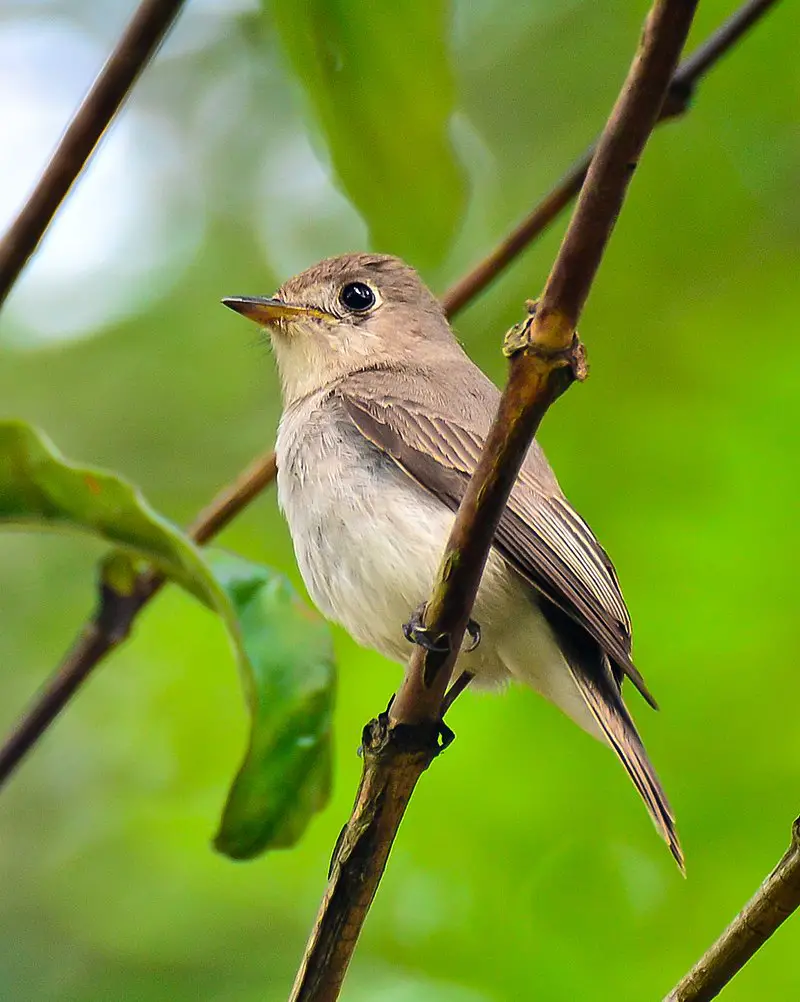
The Asian brown flycatcher is a small bird belonging to the flycatcher family Muscicapidae. Its name comes from the Latin words for “fly” and “catch.” This bird is found in Japan, eastern Siberia, and the Himalayas, and feeds primarily on insects.
Its scientific name, Muscicapa dauurica, refers to the Dauria region of south-eastern Siberia where it is found.
Known for its distinctive brown coloring, this bird is a favorite of birdwatchers and nature enthusiasts.
Despite its small size, the Asian brown flycatcher is an important part of the ecosystem, helping to control insect populations and contributing to biodiversity.Scientific classification:
| Kingdom | Animalia |
| Phylum | Chordata |
| Class | Aves |
| Order | Passeriformes |
| Family | Muscicapidae |
| Genus | Muscicapa |
| Species | M. dauurica |
Also Featured In: Birds that Migrate to Sri Lankan, Most Common Birds Live in Osaka
49. Eastern Marsh Harrier
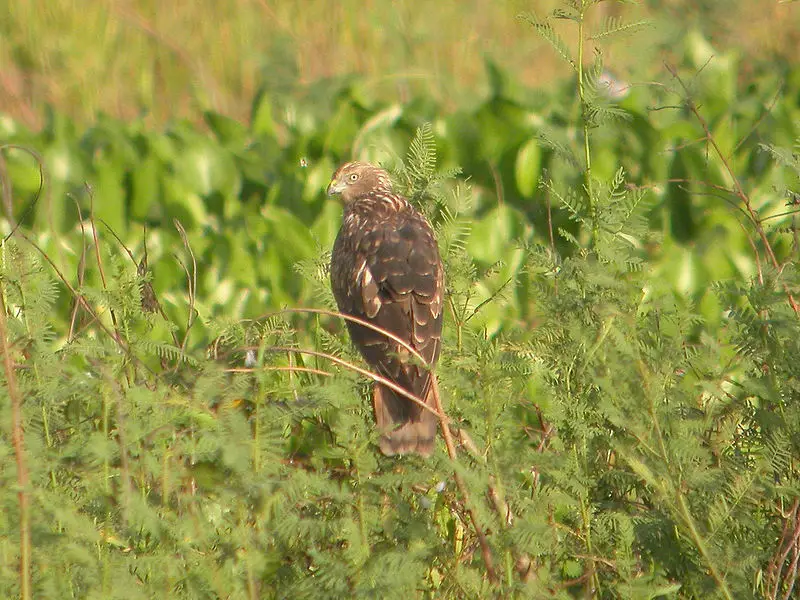
The Eastern marsh harrier is a bird of prey that belongs to the harrier group. It is similar to the Western marsh harrier, but is now classified as a separate species.
There are two subspecies of the Eastern marsh harrier – C. s. spilonotus in eastern Asia and C. s. spilothorax in New Guinea. It is a skilled hunter, known for its ability to catch prey in mid-air.
The Eastern marsh harrier’s habitat is usually wetlands and marshes. It is a migratory bird and can be found in countries like China, Japan, and Russia.
The Eastern marsh harrier is an important predator in its ecosystem and helps to maintain a balance in the food chain.Scientific classification:
| Kingdom | Animalia |
| Phylum | Chordata |
| Class | Aves |
| Order | Accipitriformes |
| Family | Accipitridae |
| Genus | Circus |
| Species | C. spilonotus |
Also Featured In: Birds You’ll Find in Hokkaido,
50. Chinese Grassbird
The Chinese grassbird is a bird species that belongs to the family Pellorneidae. It was previously categorized under Sylviidae and Timaliidae.
The bird is commonly found in freshwater swamps and along the banks of rivers in lowland areas of southeastern China, Bangladesh, southeastern Myanmar, south-central Thailand, Cambodia, and the northern parts of Laos and Vietnam.
Chinese grassbirds are often seen in tall emergent vegetation, where they tend to forage for insects and small invertebrates.
These birds are known for their distinct striped plumage, which helps them blend into their surroundings.
As with many bird species in the region, the Chinese grassbird is threatened by habitat loss due to land development and agriculture.
Conservation efforts are being made to protect their natural habitats and populations.Scientific classification:
| Kingdom | Animalia |
| Phylum | Chordata |
| Class | Aves |
| Order | Passeriformes |
| Family | Pellorneidae |
| Genus | Graminicola |
| Species | G. striatus |
51. Plain Flowerpecker
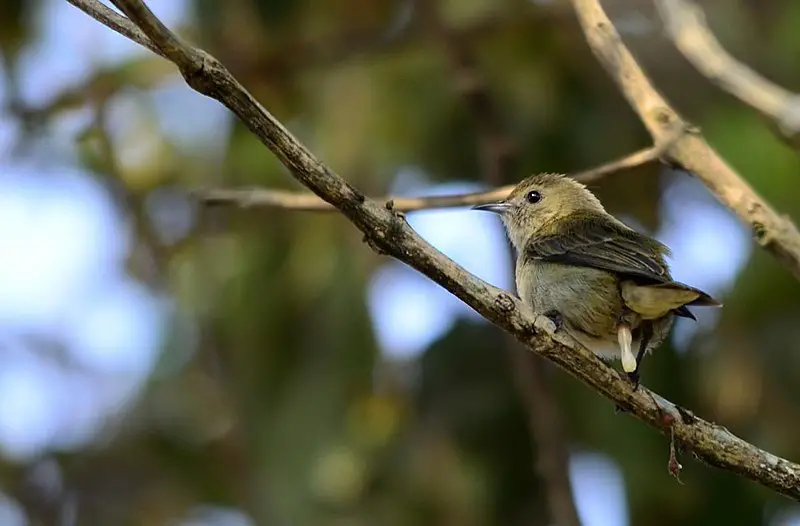
The Plain flowerpecker bird belongs to the Dicaeidae family and was first identified by Robert Swinhoe in 1870. Its small size, about 9 cm long, makes it difficult to differentiate between male and female birds.
This species can be found in the central Himalayas and extends through western Indonesia to Taiwan. It is also found in northeastern India and neighboring countries such as Myanmar, Laos, and southern China.
It is known for its plain appearance, with no distinctive markings, and is often spotted near flowers.
The Plain flowerpecker feeds on nectar and insects found in flowers and is an important pollinator.
Their contribution to pollination makes them essential to their ecosystem. The survival of these tiny birds is vital for the health and sustainability of their habitats.Scientific classification:
| Kingdom | Animalia |
| Phylum | Chordata |
| Class | Aves |
| Order | Passeriformes |
| Family | Dicaeidae |
| Genus | Dicaeum |
| Species | D. minullum |